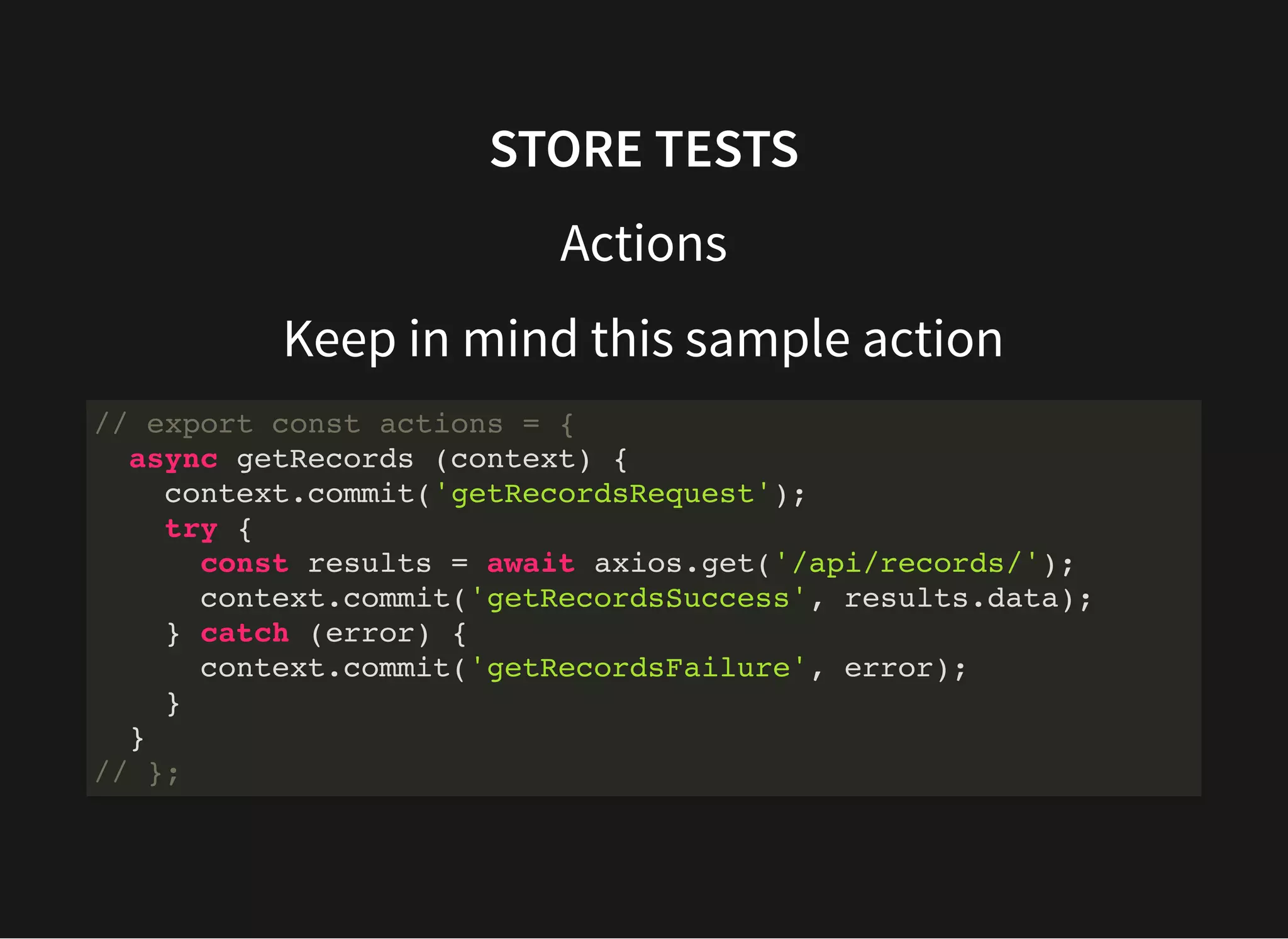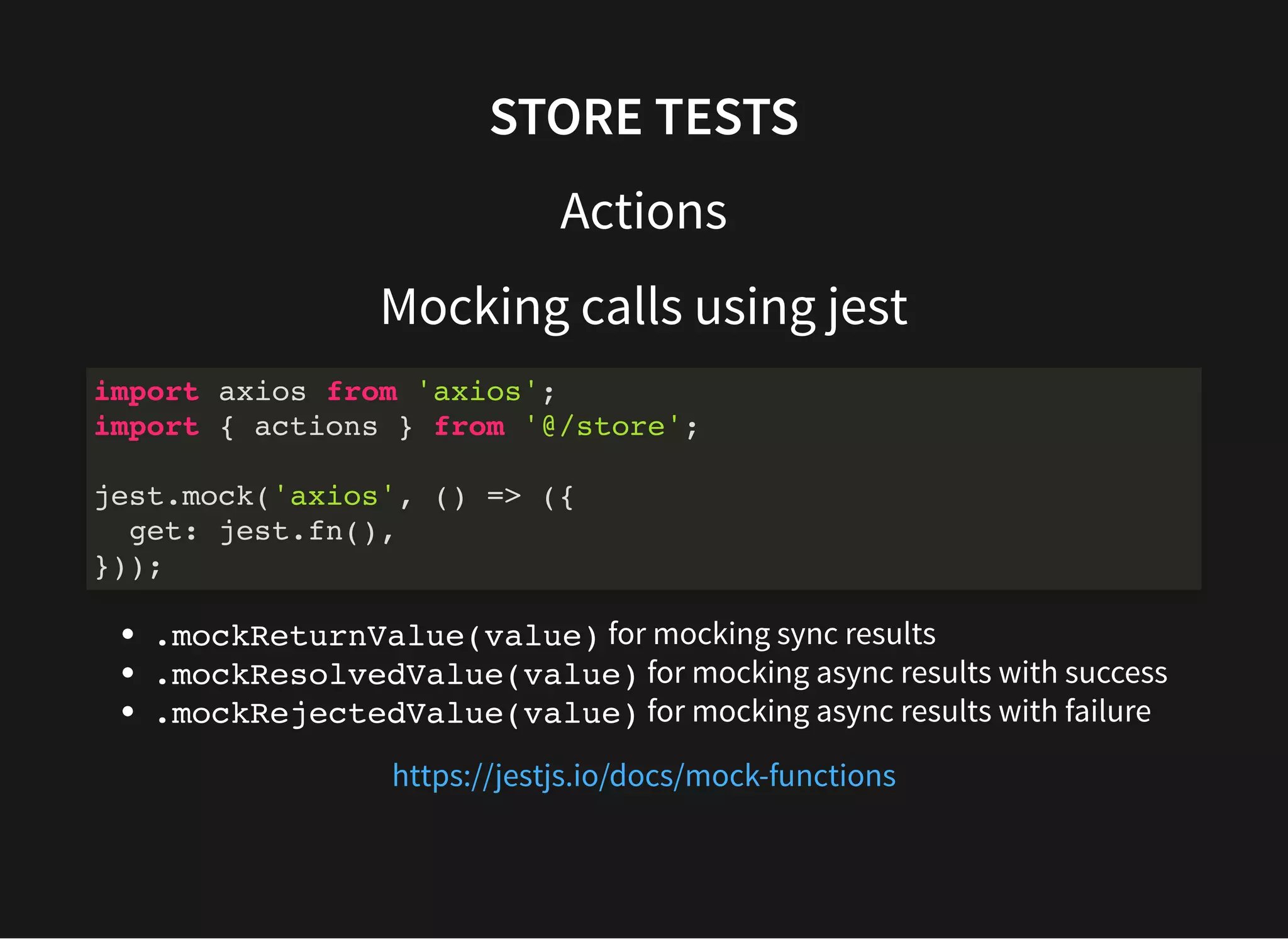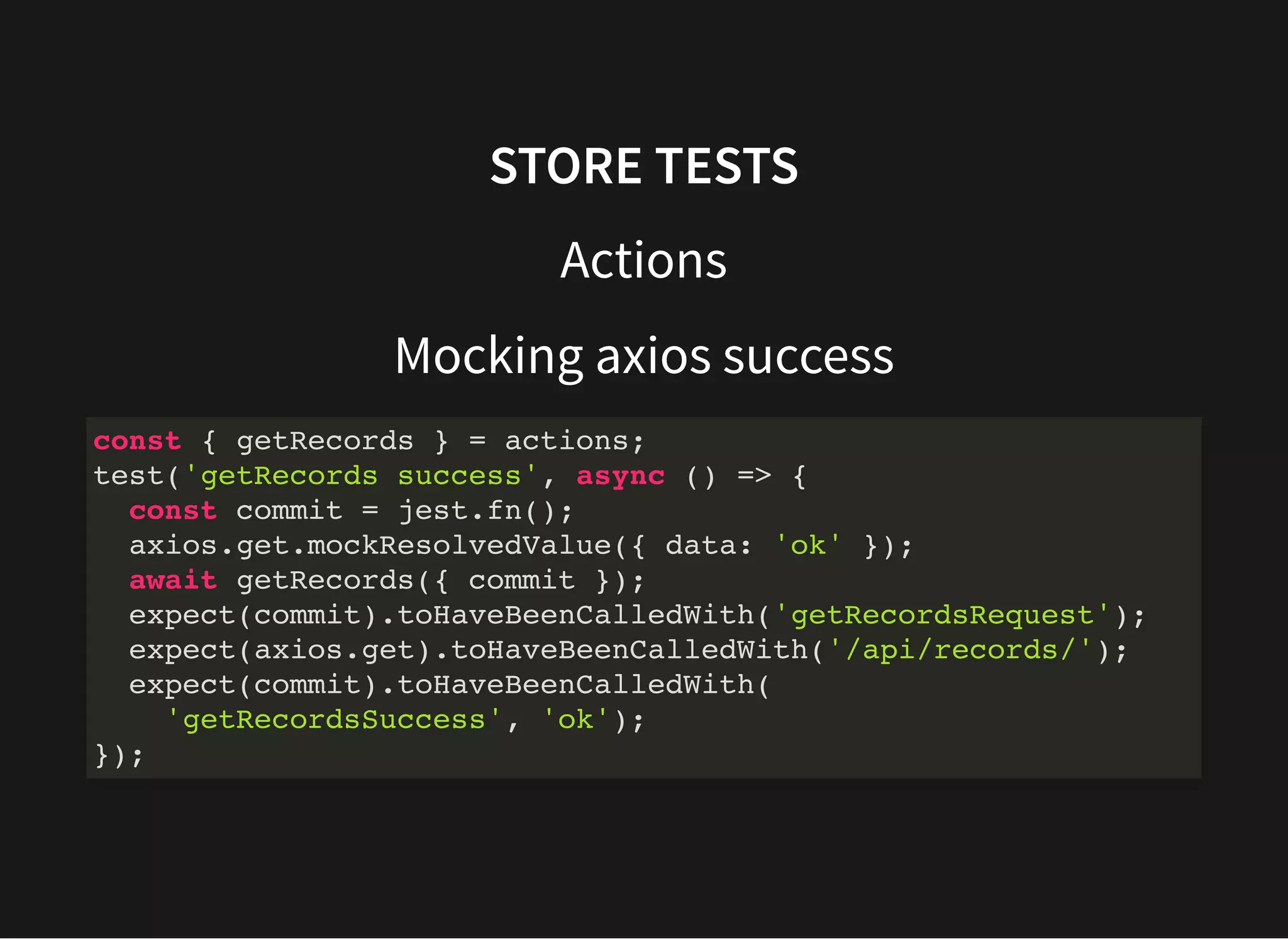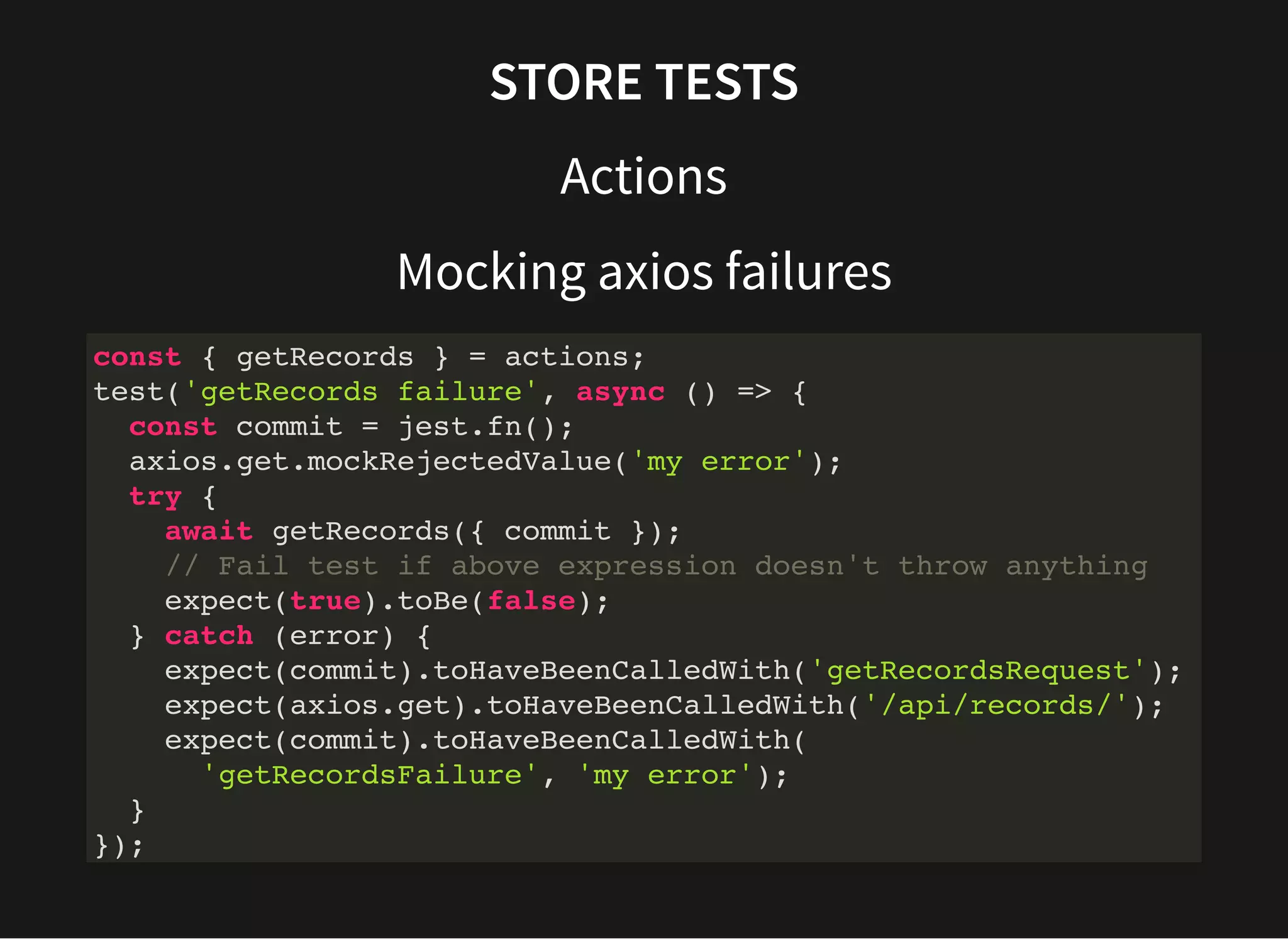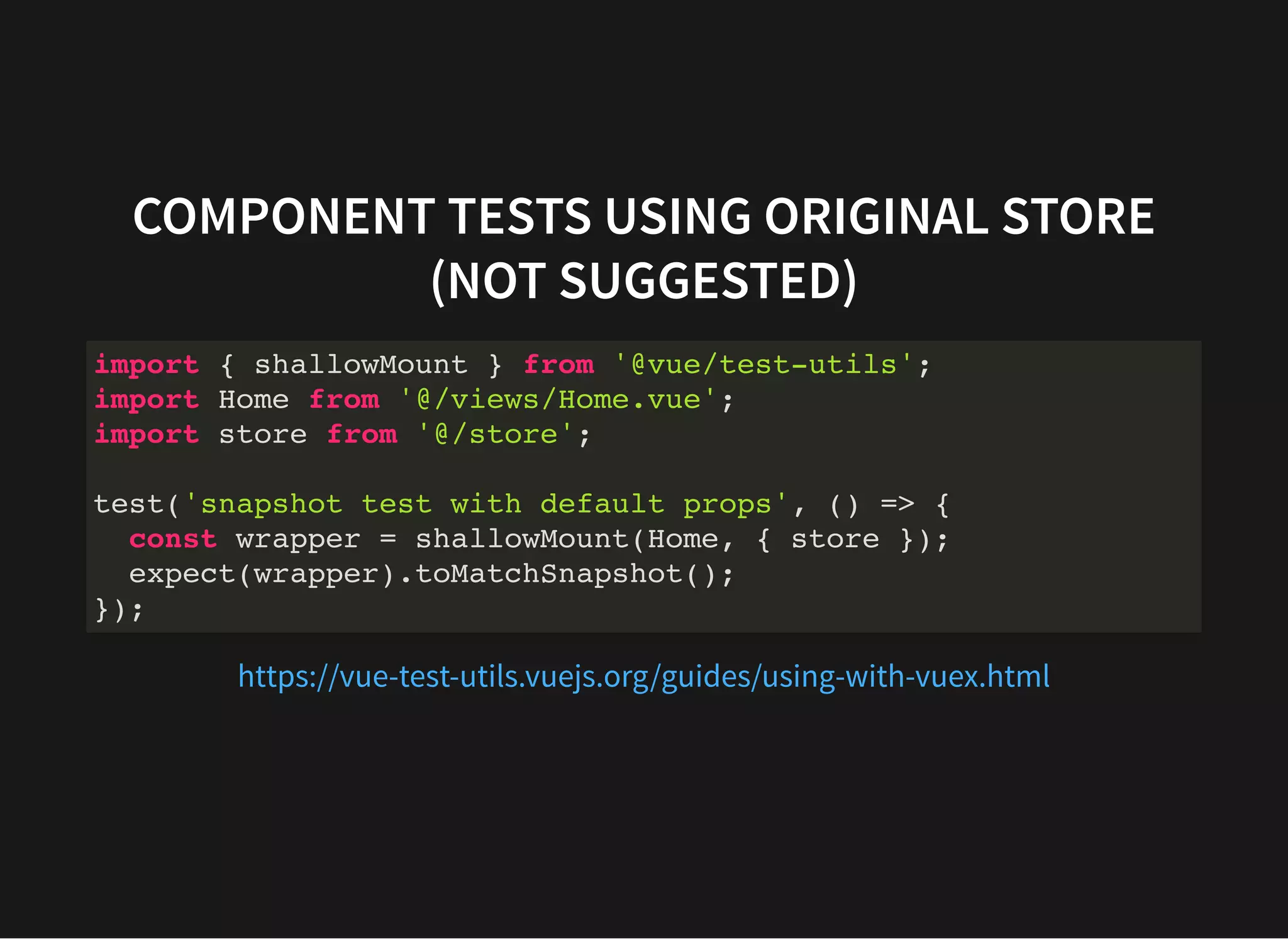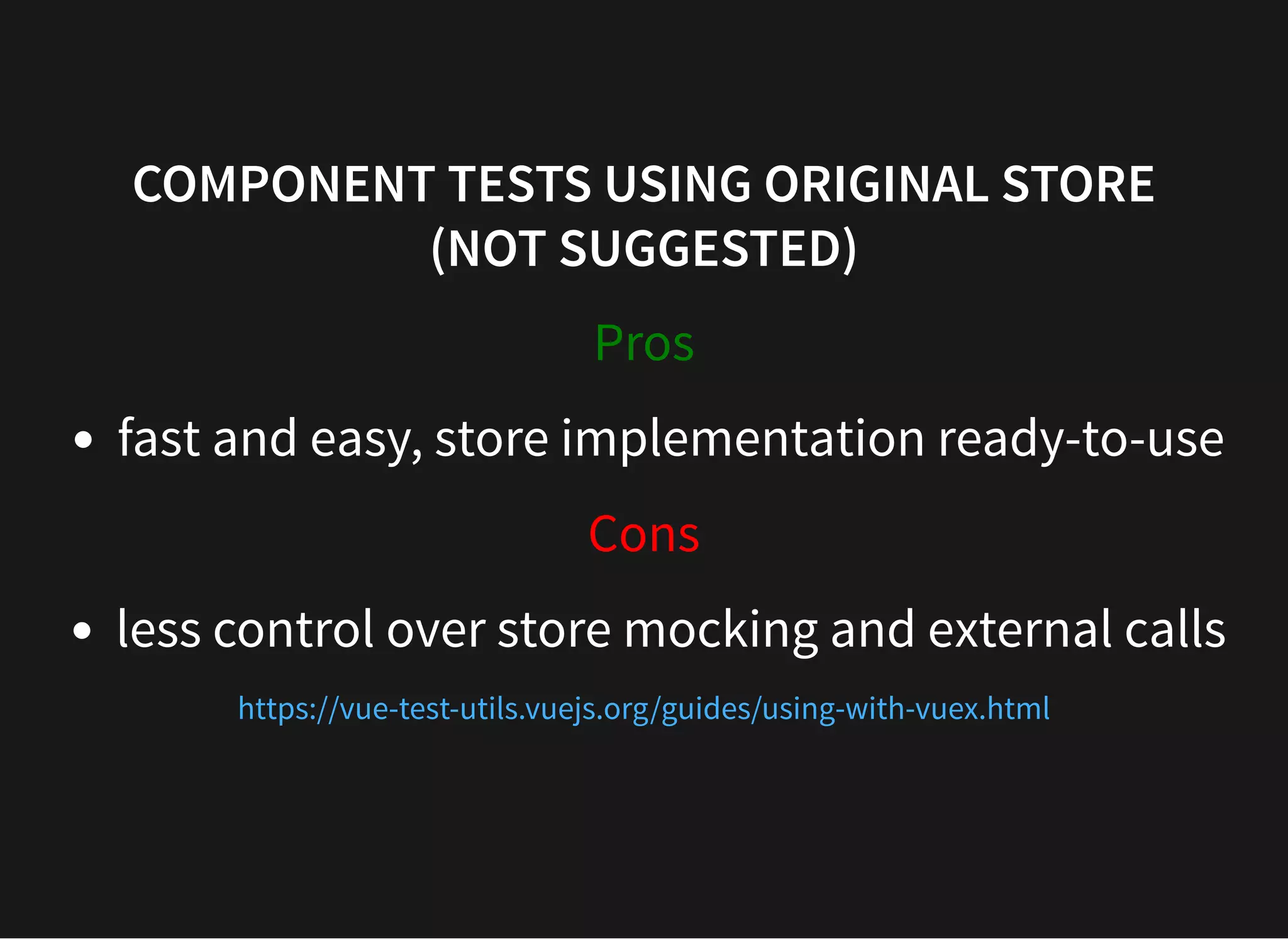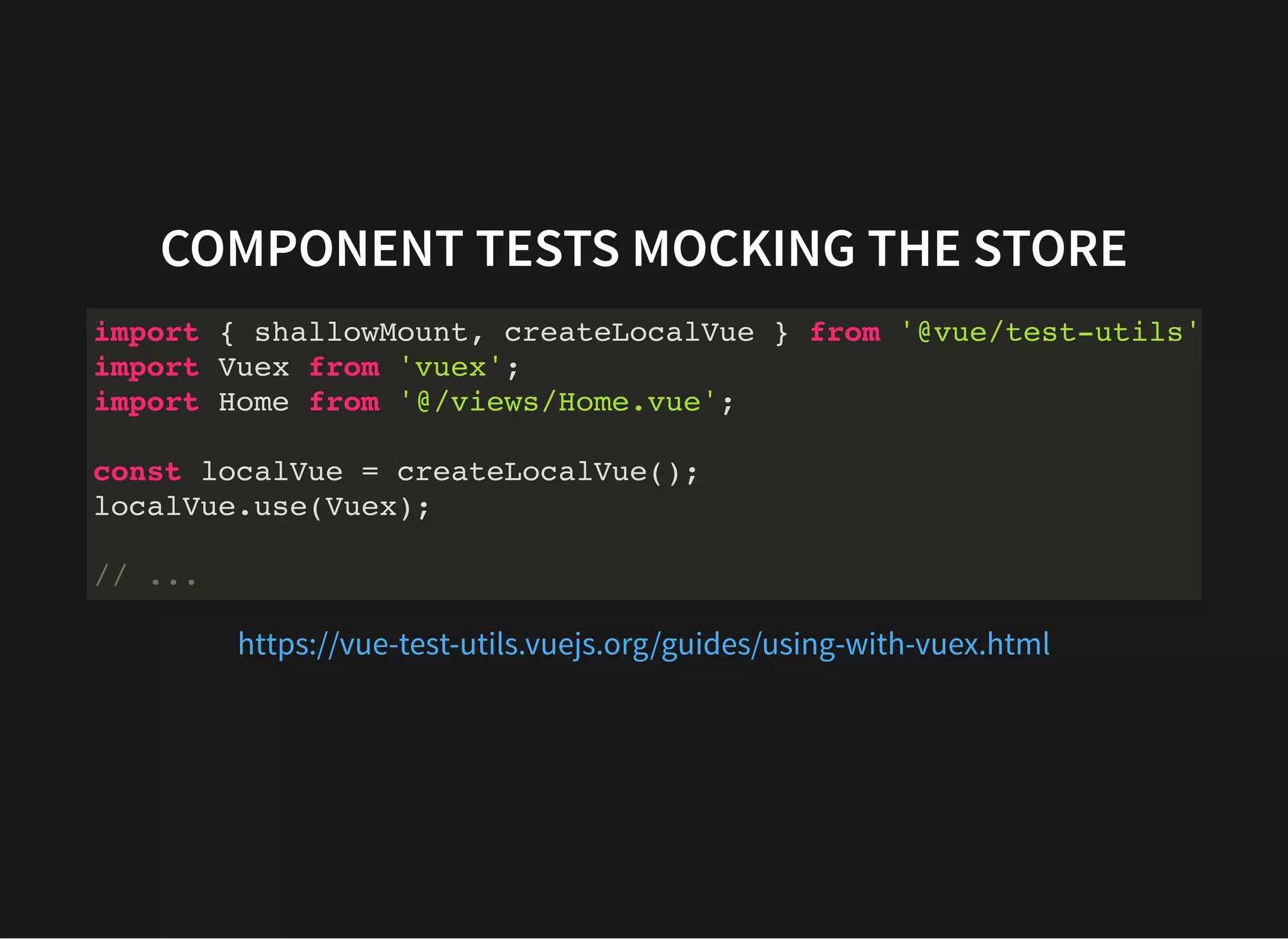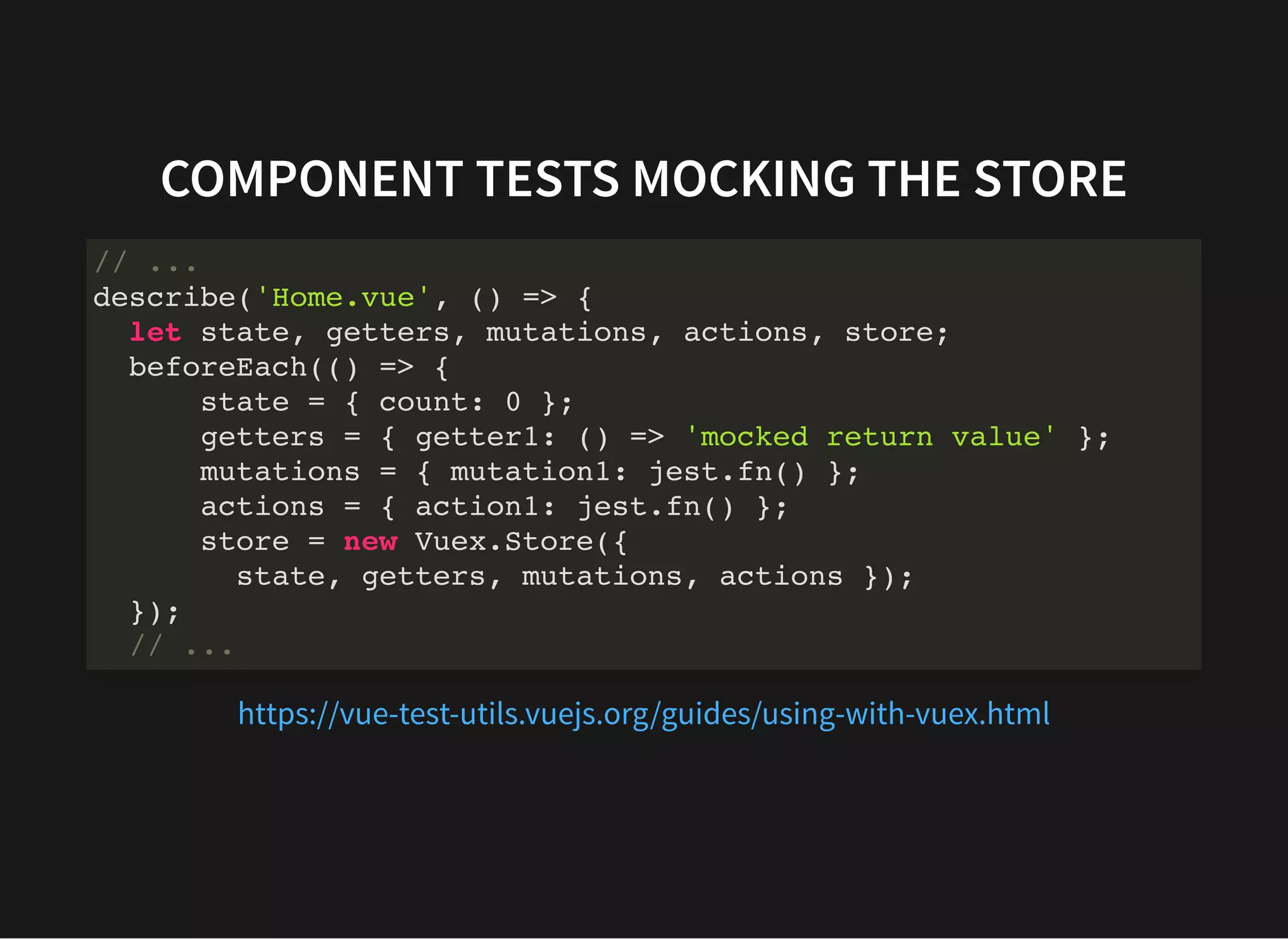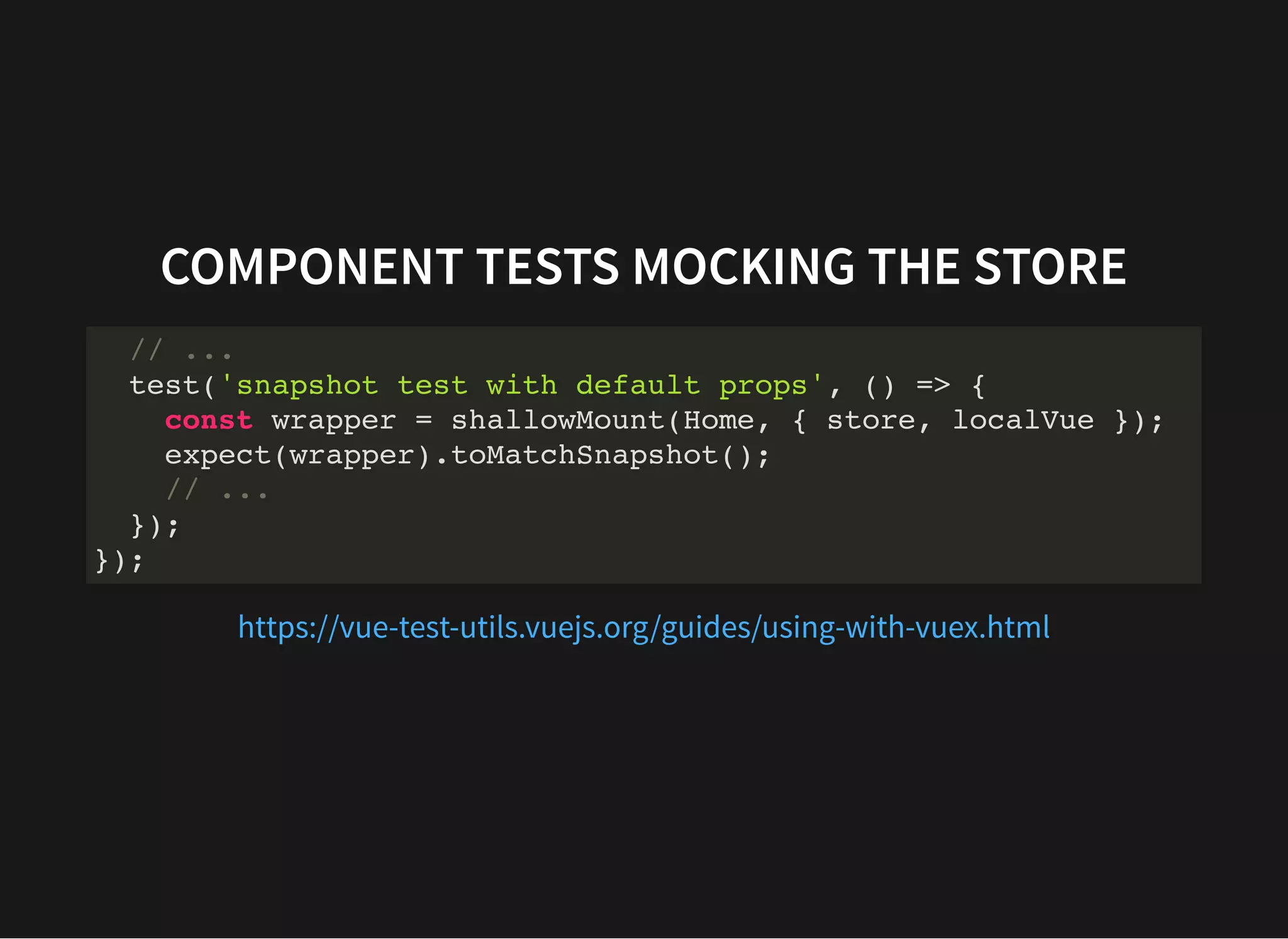The document serves as a comprehensive guide on integrating Vuex into Vue.js projects, covering installation, configuration, and usage of Vuex for state management. It includes code examples for implementing components, mutations, actions, and testing in both simple and complex applications. Additionally, it discusses the trade-offs of using Vuex versus managing state within components directly, emphasizing its benefits for larger applications.


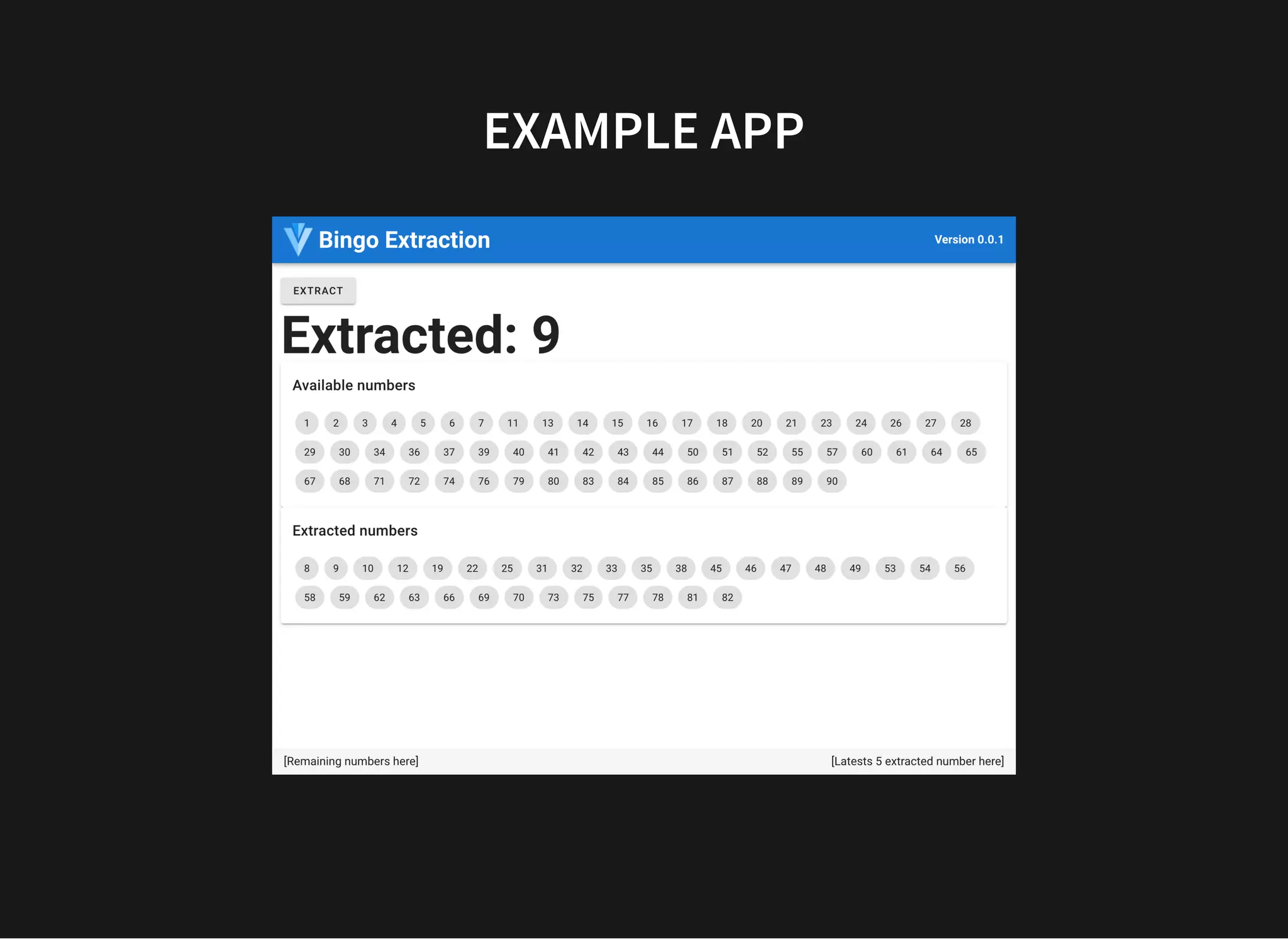
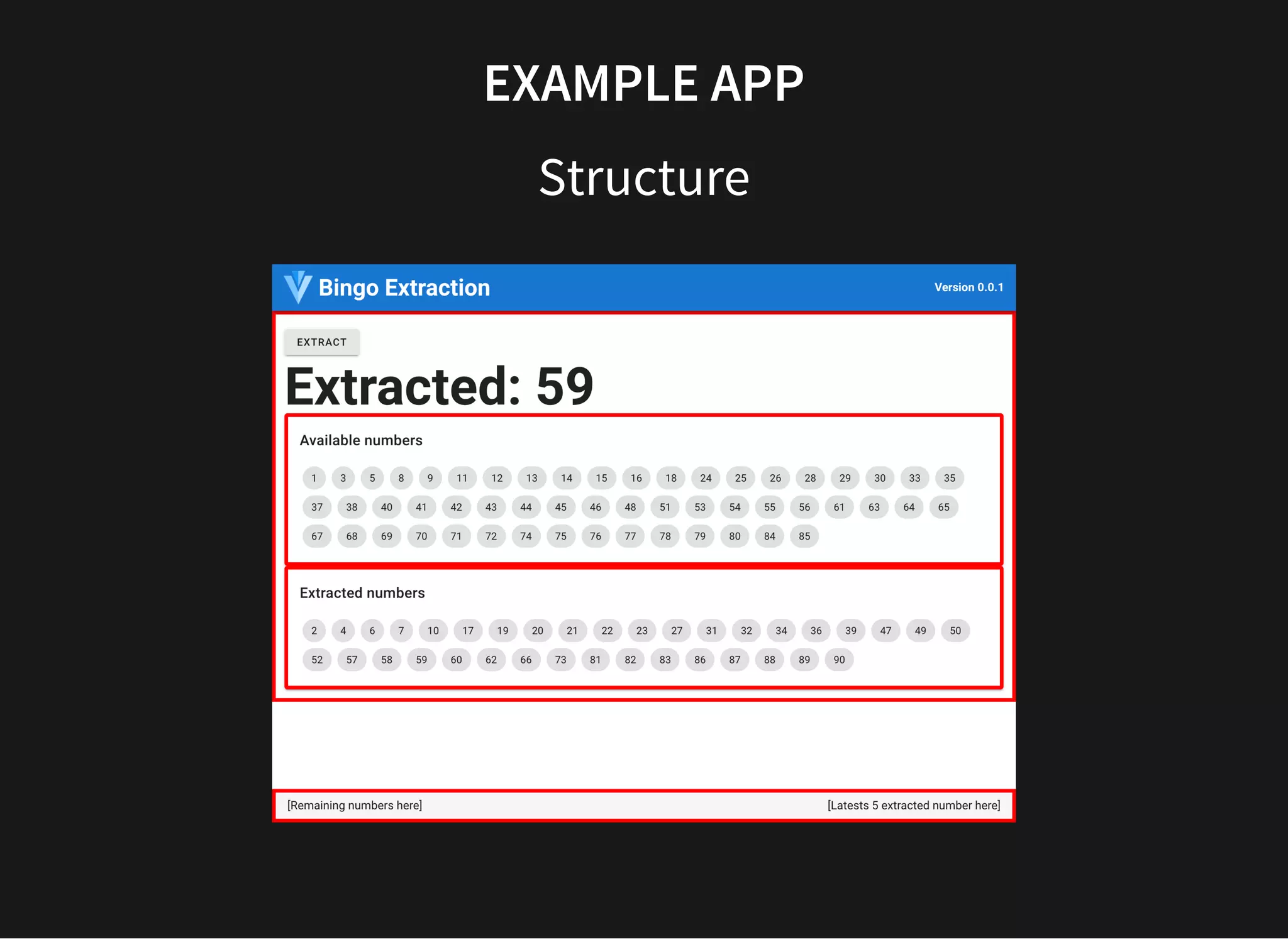
![EXAMPLE APP Main component, data() export default { name: 'Home', data() { // component's state return { availableNumbers: [...Array(90).keys()] .map((i) => i + 1), extractedNumbers: [], }; }, // ... };](https://image.slidesharecdn.com/introducing-vuex-210524093112/75/State-manager-in-Vue-js-from-zero-to-Vuex-5-2048.jpg)
![EXAMPLE APP Main component, computed export default { // ... computed: { // component's getters ascendingExtractedNumbers() { return [...this.extractedNumbers].sort((a, b) => a - b); }, }, // ... };](https://image.slidesharecdn.com/introducing-vuex-210524093112/75/State-manager-in-Vue-js-from-zero-to-Vuex-6-2048.jpg)
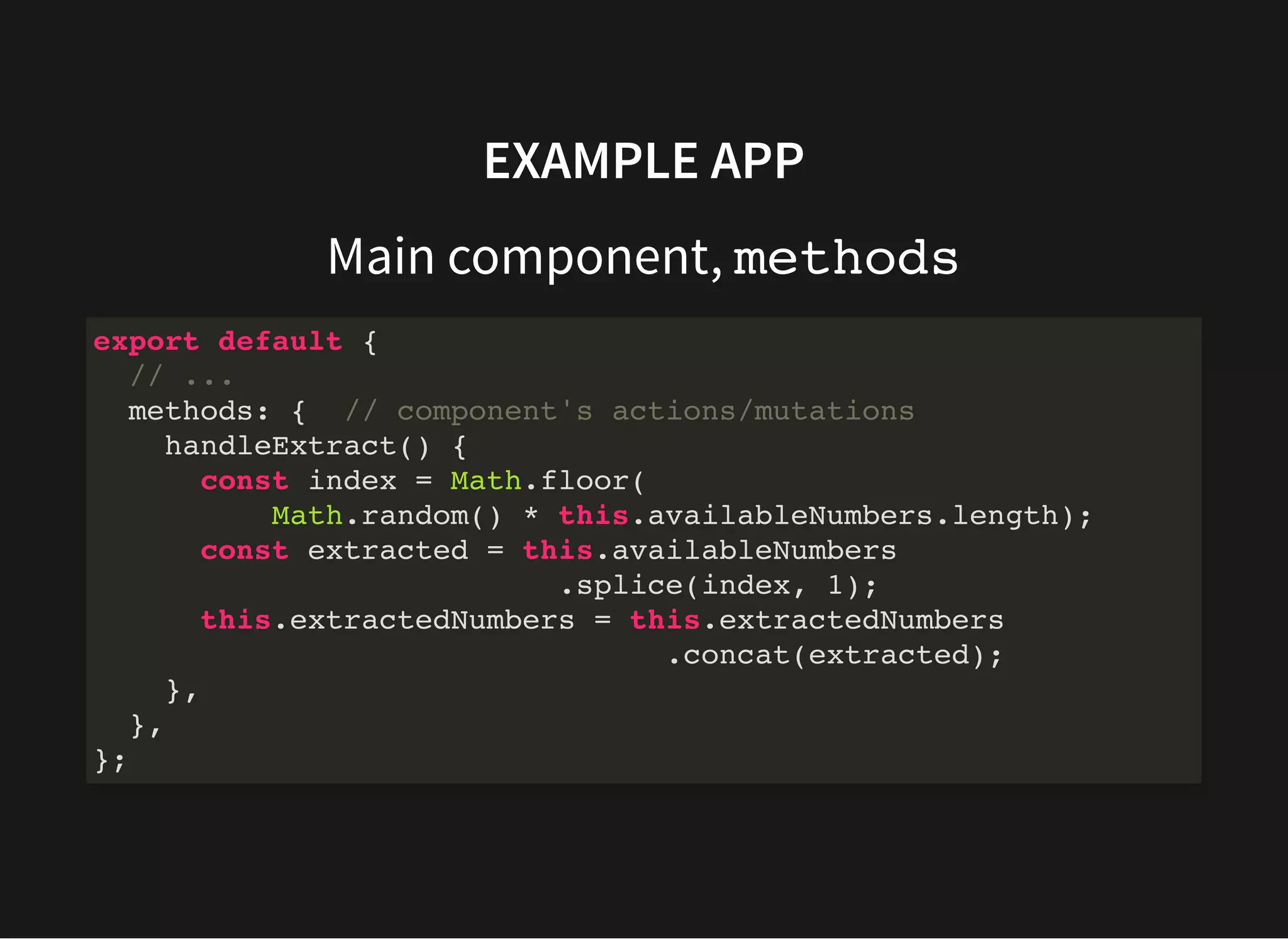
![EXAMPLE APP Main component template <button @click="handleExtract">Extract</button> <h1> Extracted: {{ extractedNumbers[extractedNumbers.length - 1] }} </h1> <DisplayNumbers title="Available numbers" :numbers="availableNumbers" /> <DisplayNumbers title="Extracted numbers" :numbers="ascendingExtractedNumbers" />](https://image.slidesharecdn.com/introducing-vuex-210524093112/75/State-manager-in-Vue-js-from-zero-to-Vuex-8-2048.jpg)
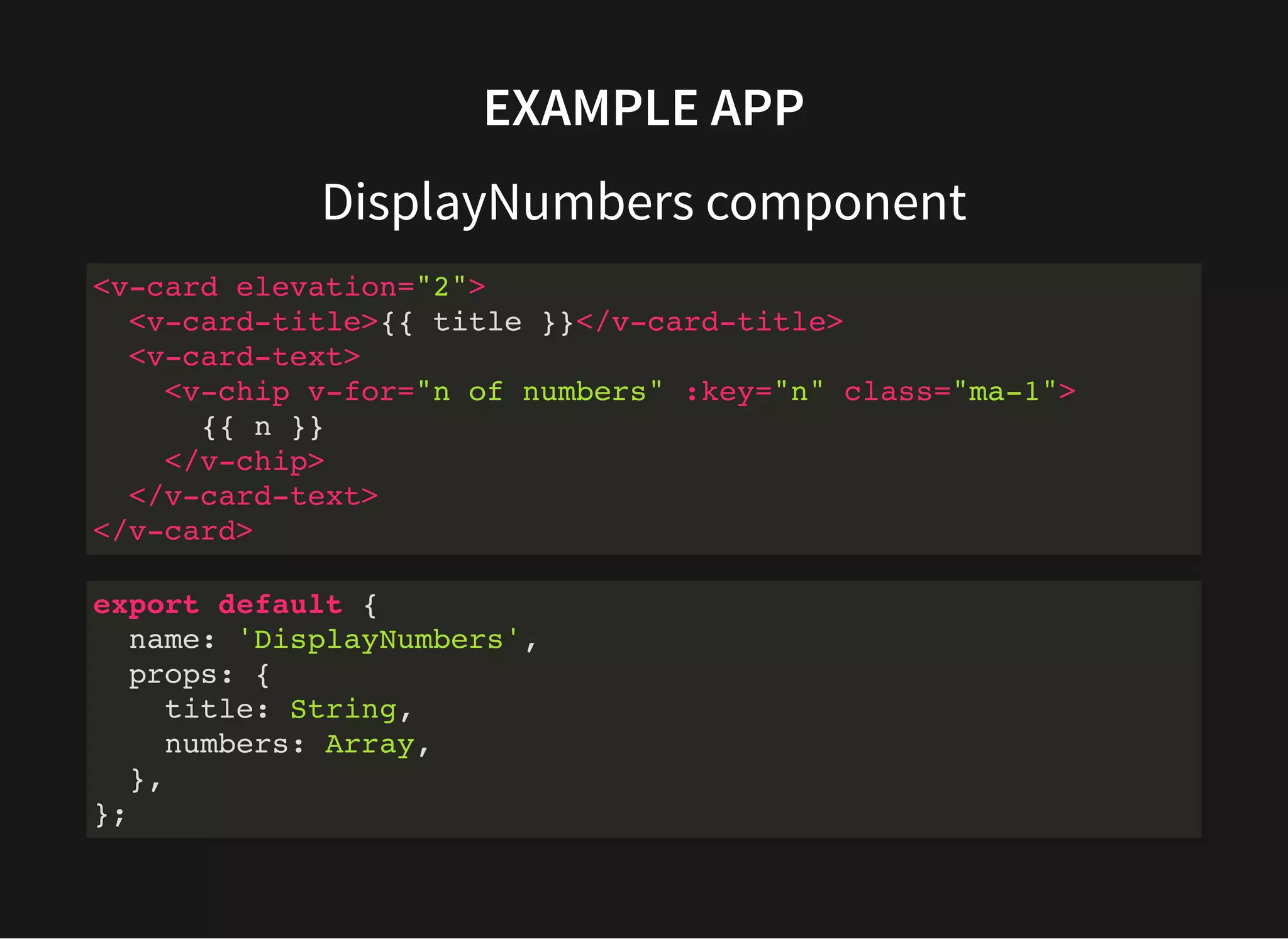
![COMPONENT TESTS DisplayNumbers import { shallowMount } from '@vue/test-utils'; import DisplayNumbers from '@/components/DisplayNumbers.vue'; test('renders as expected', () => { const wrapper = shallowMount(DisplayNumbers, { stubs: ['v-container', 'v-card', 'v-card-title', 'v-card-t propsData: { title: 'title text', numbers: [1, 2, 3, 4, 5, 6, 7, 8, 9, 10], }, }); expect(wrapper).toMatchSnapshot(); });](https://image.slidesharecdn.com/introducing-vuex-210524093112/75/State-manager-in-Vue-js-from-zero-to-Vuex-10-2048.jpg)
![COMPONENT TESTS Home #1 import { shallowMount } from '@vue/test-utils'; import Home from '@/views/Home.vue'; const shallowMountComponent = () => shallowMount(Home, { stubs: ['v-container', 'v-btn', 'v-row', 'v-col'], }); test('renders as expected', () => { const wrapper = shallowMountComponent(); expect(wrapper).toMatchSnapshot(); }); // ...](https://image.slidesharecdn.com/introducing-vuex-210524093112/75/State-manager-in-Vue-js-from-zero-to-Vuex-11-2048.jpg)
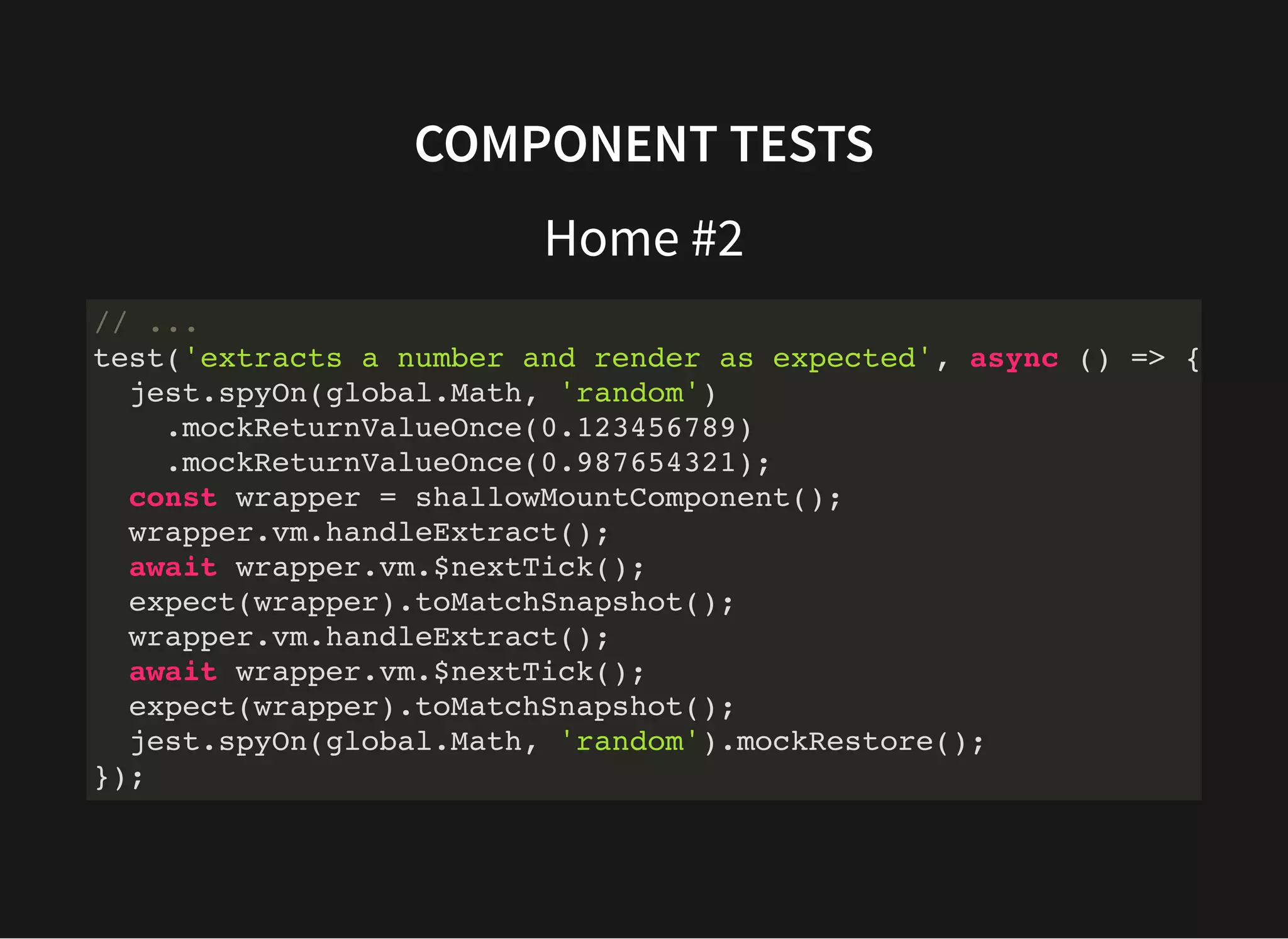
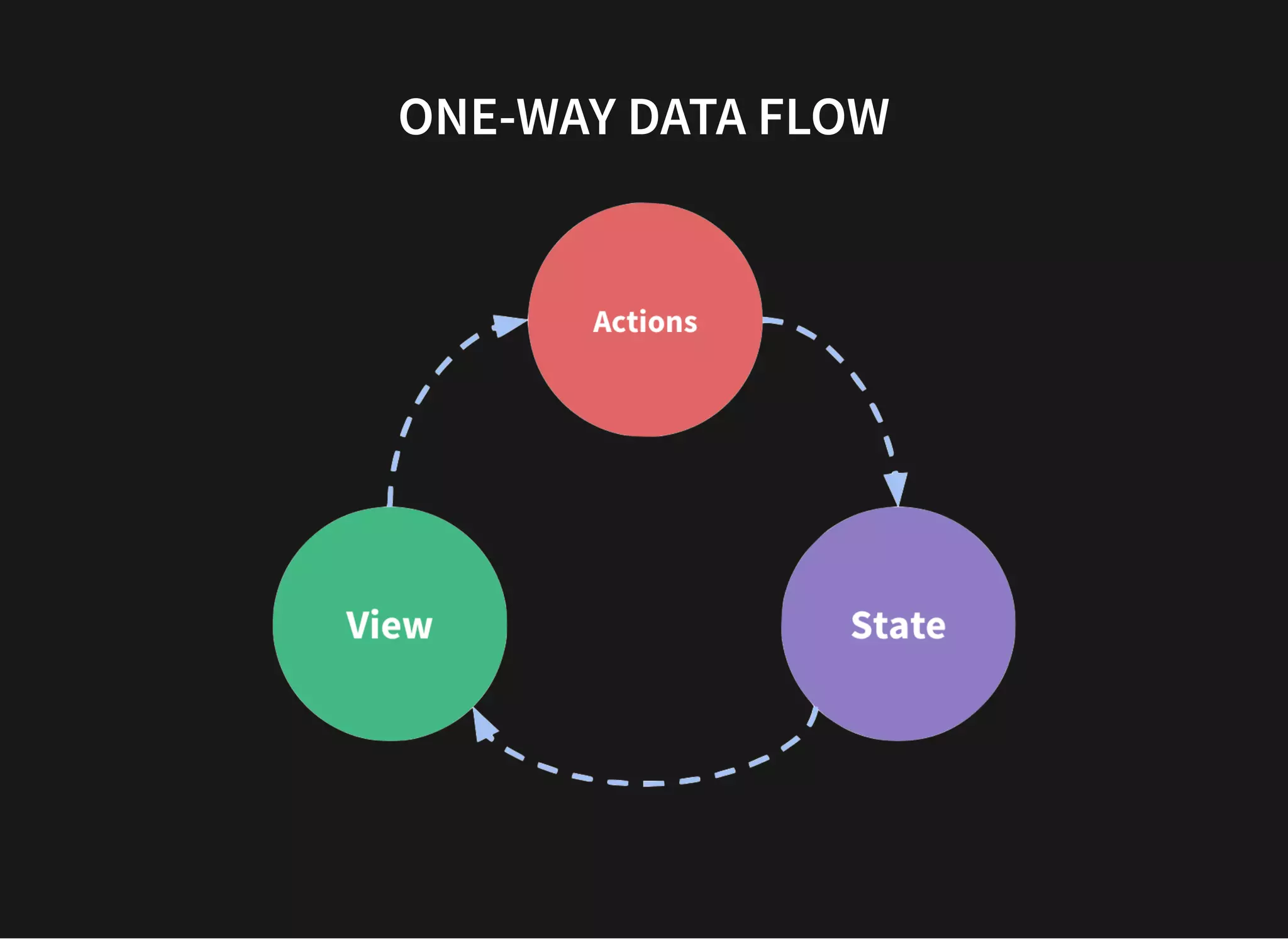
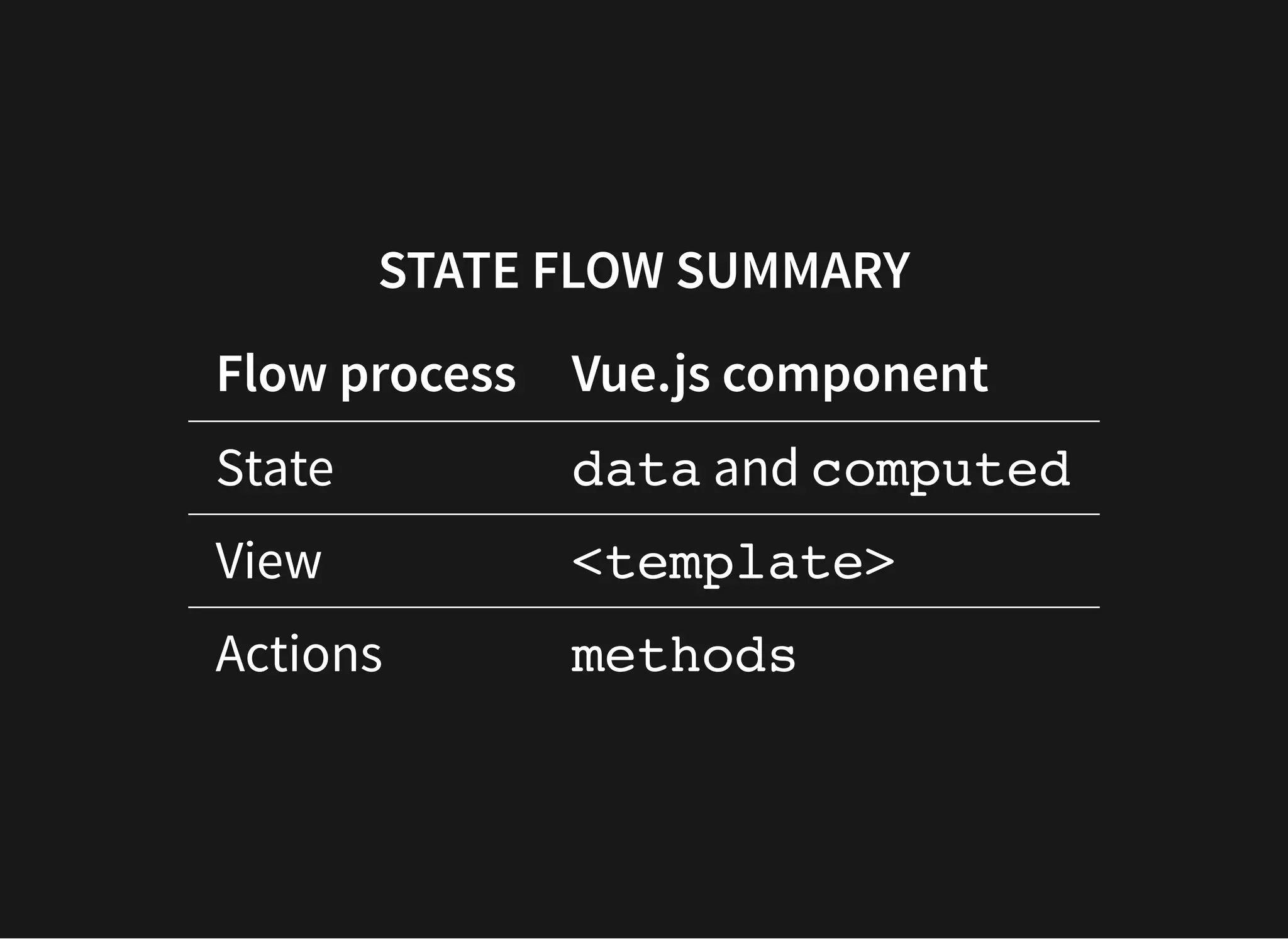
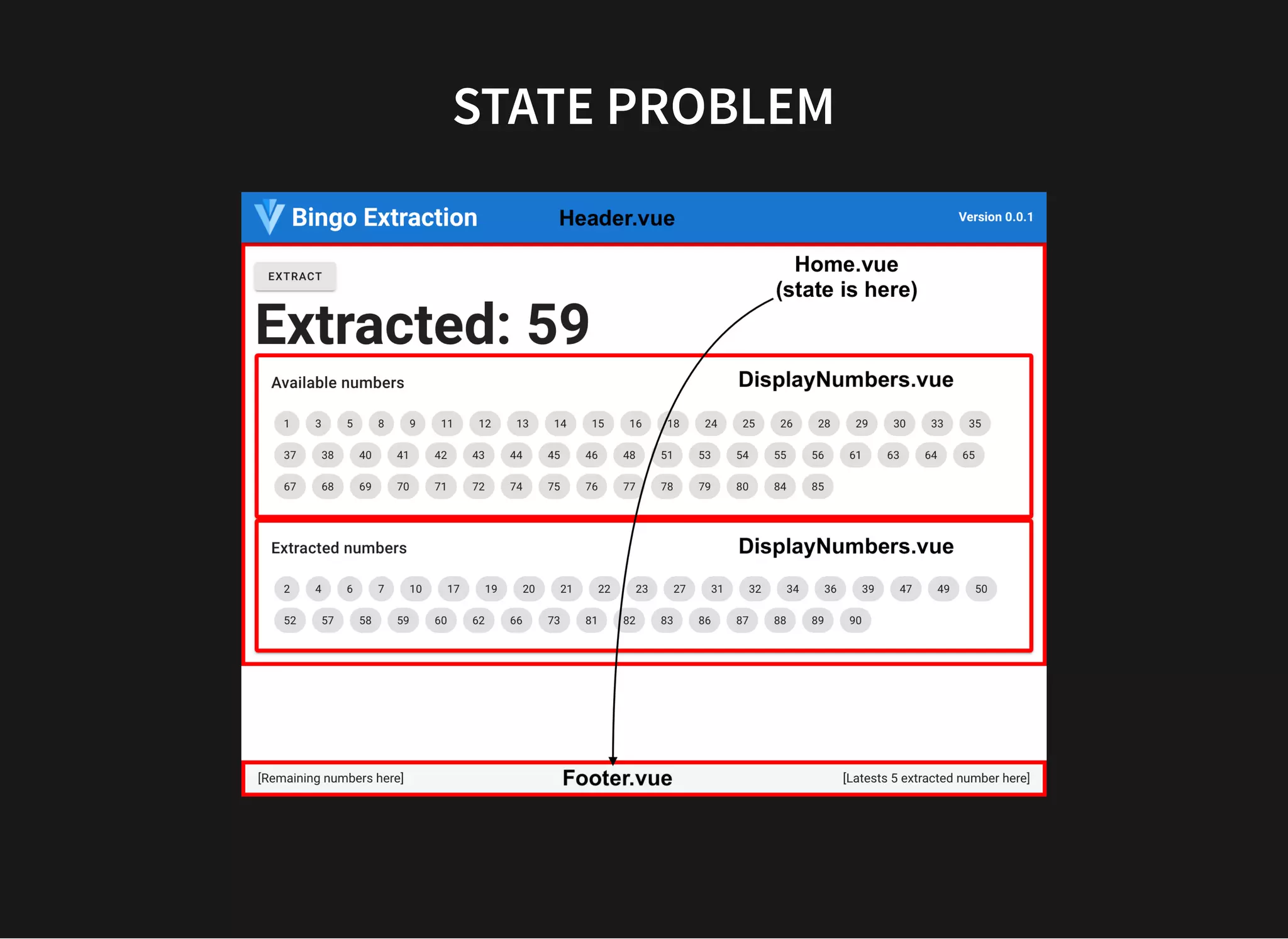
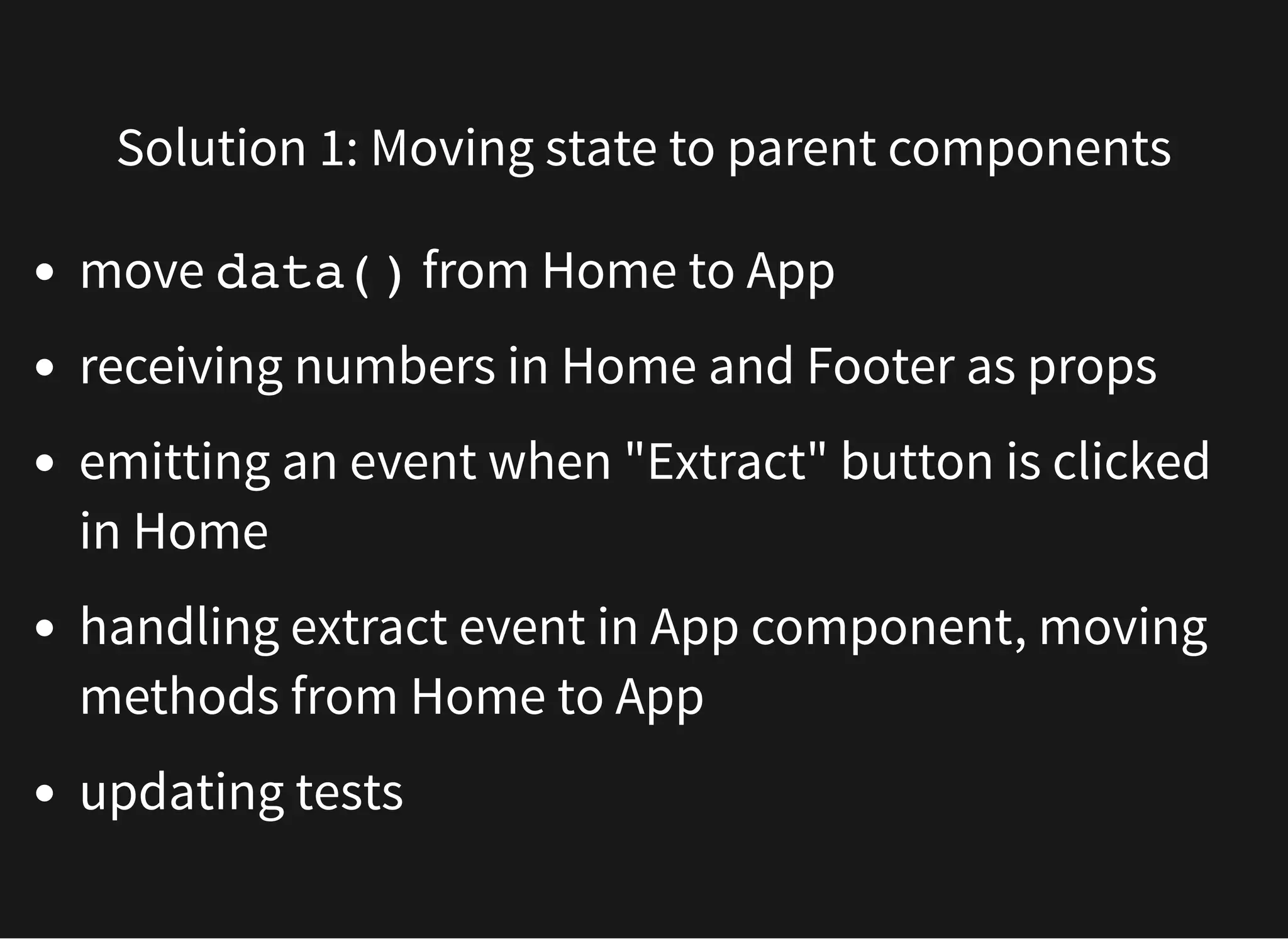
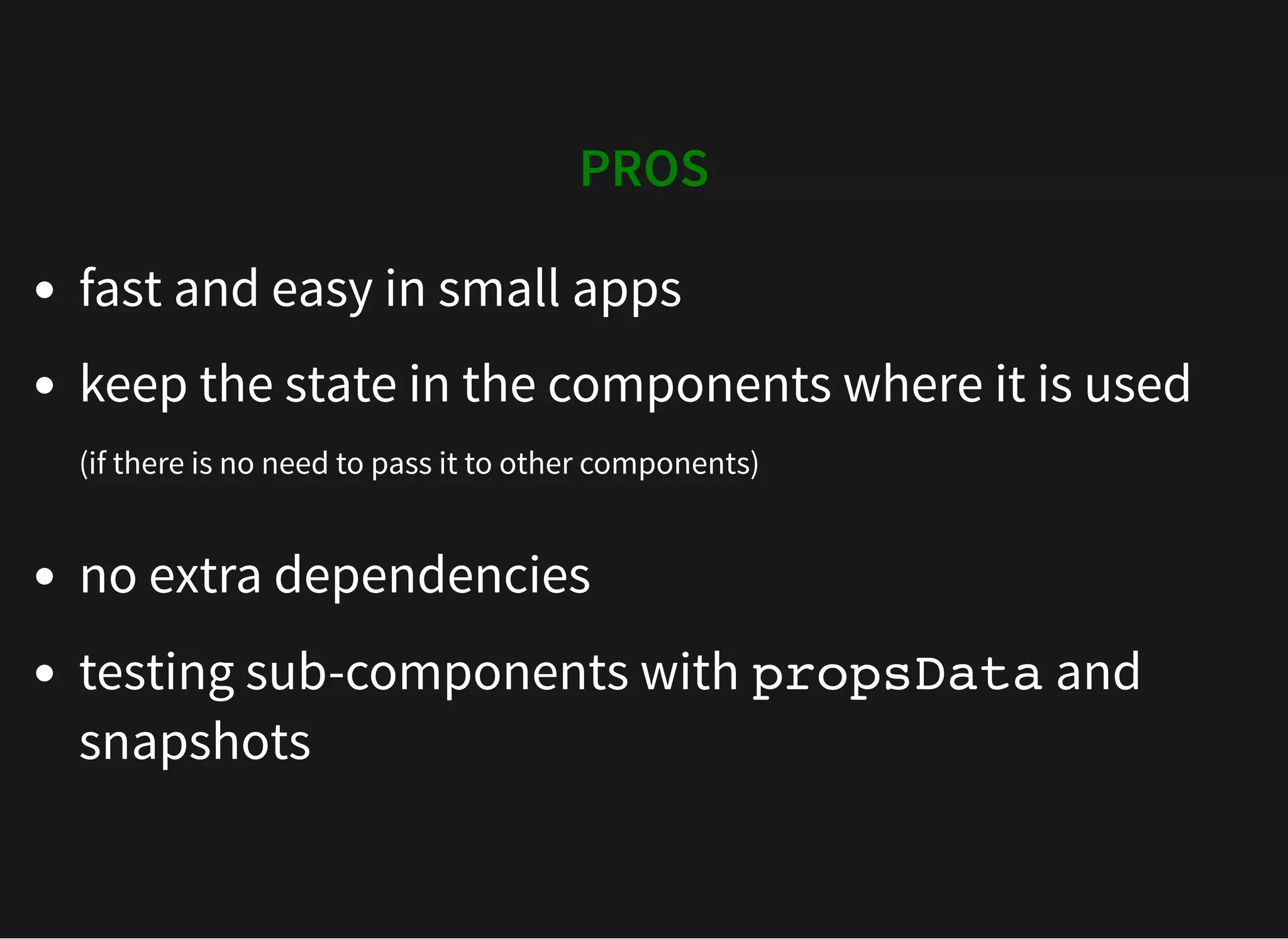






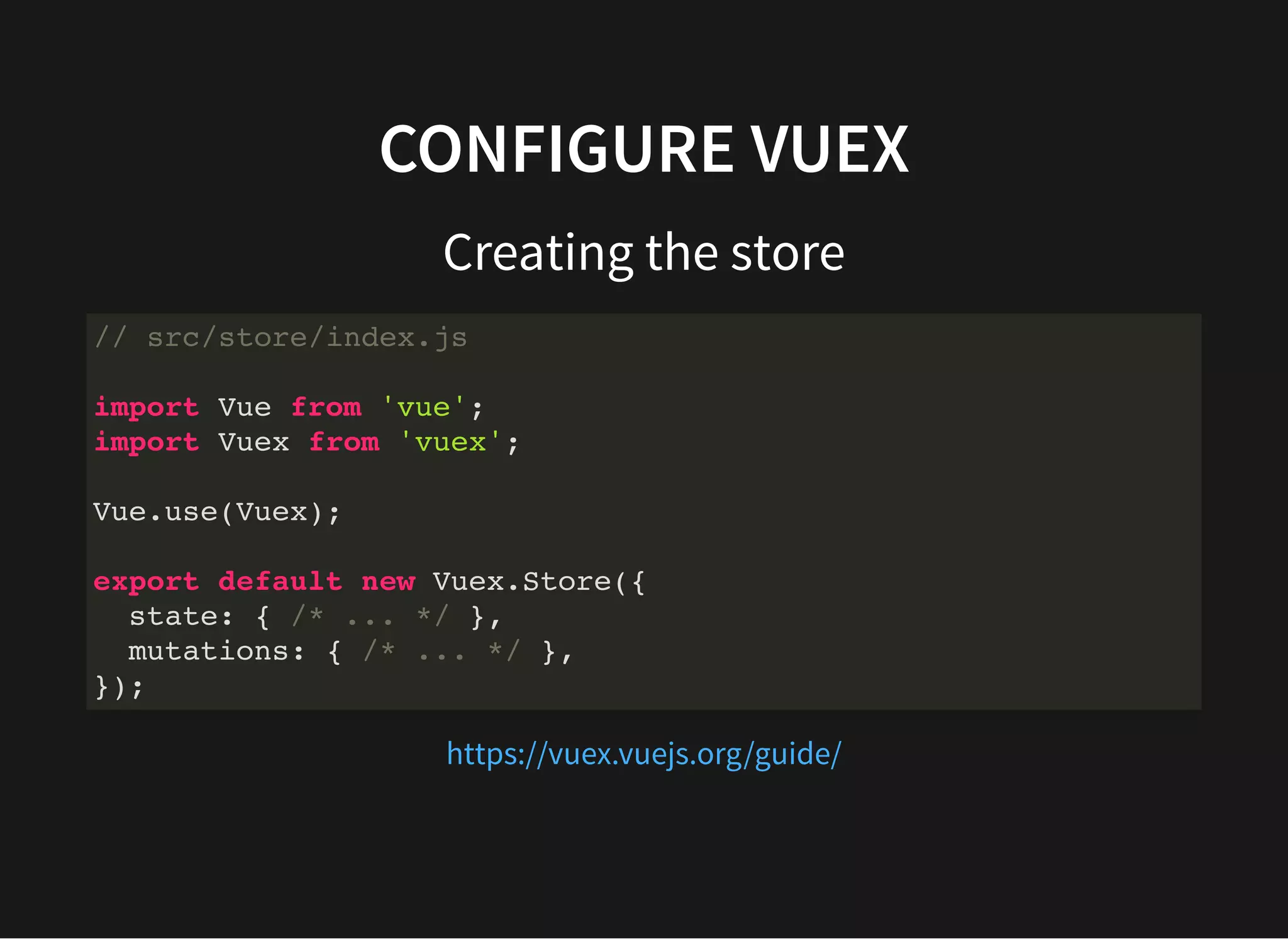

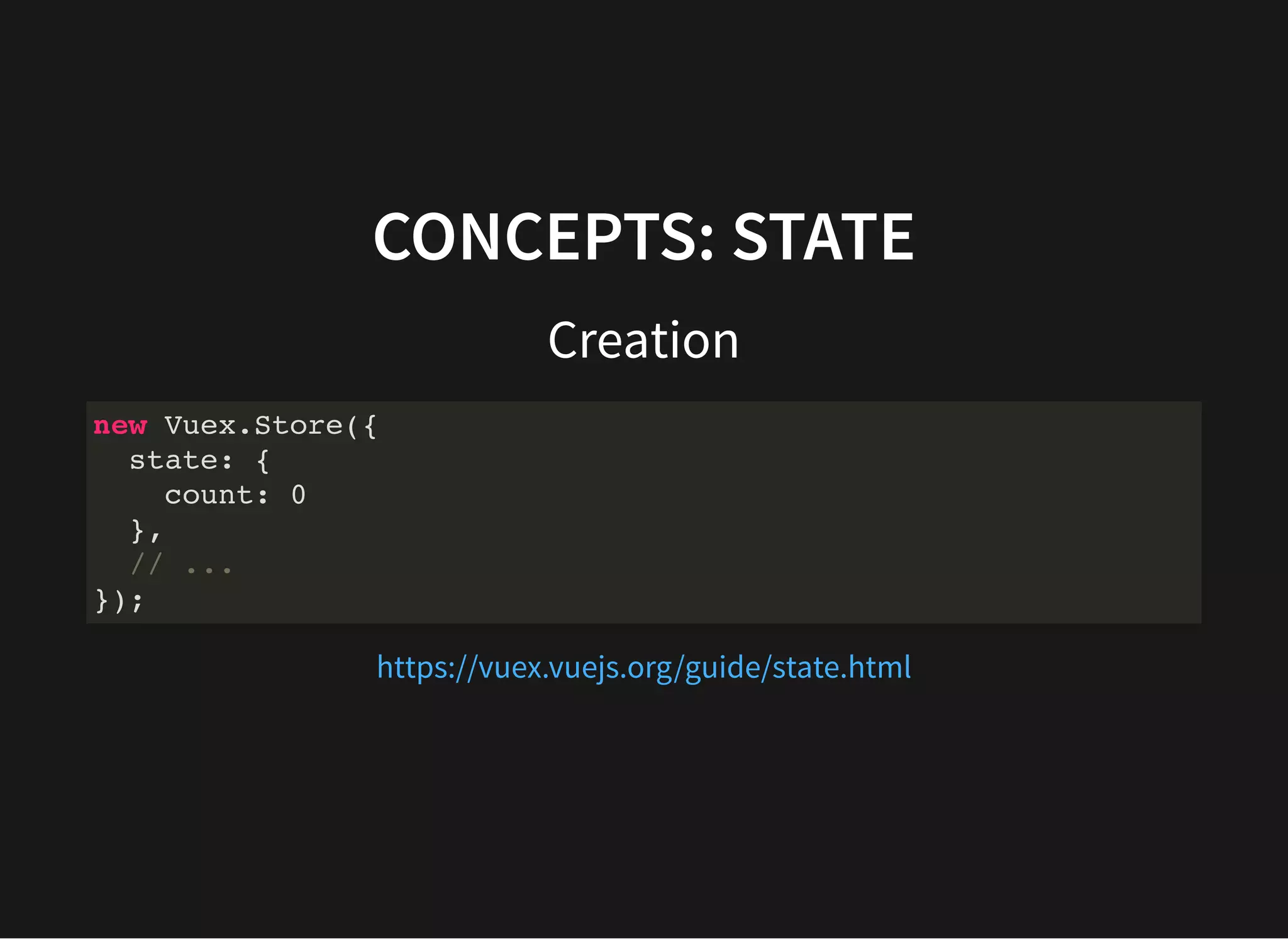
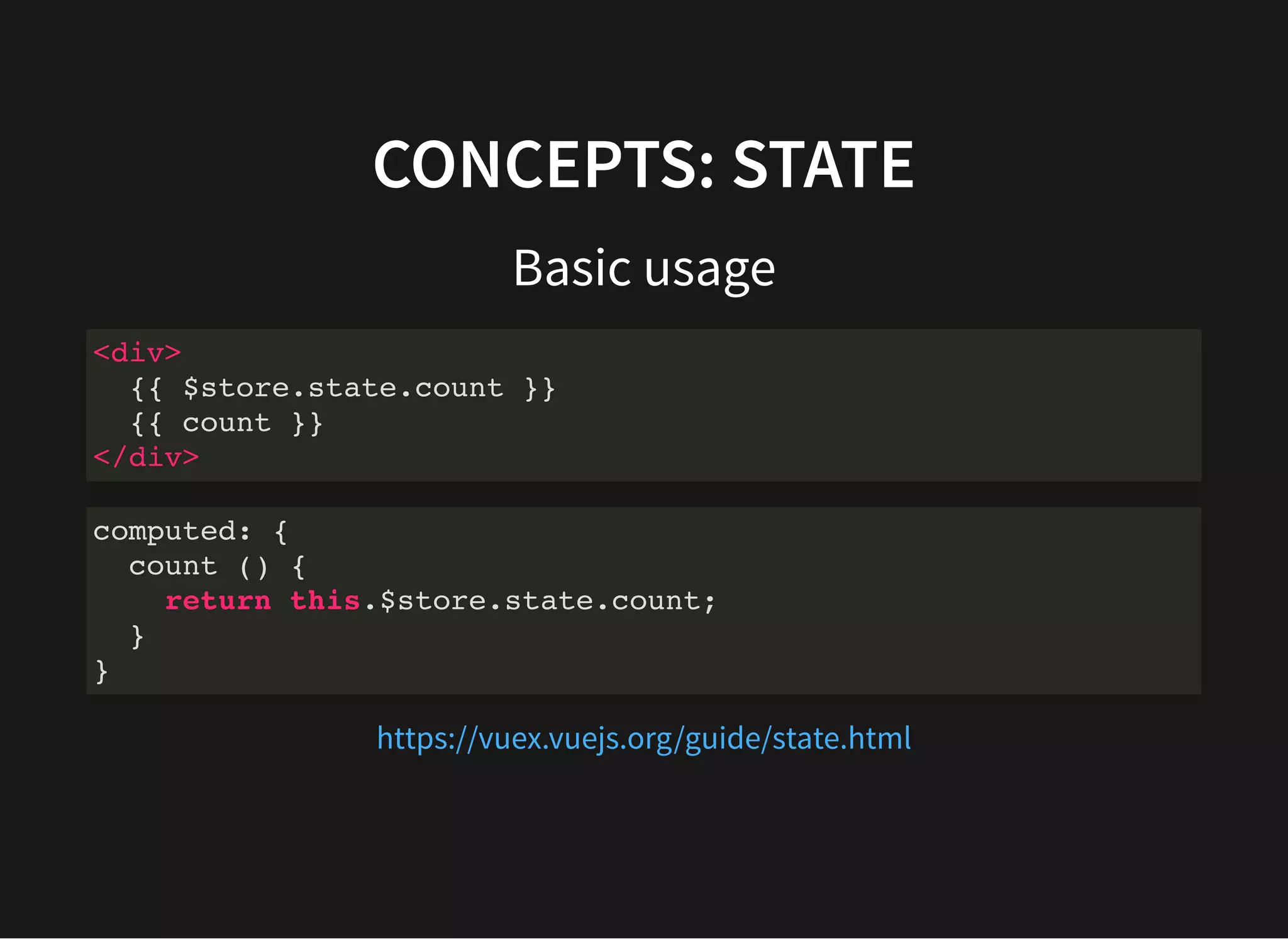
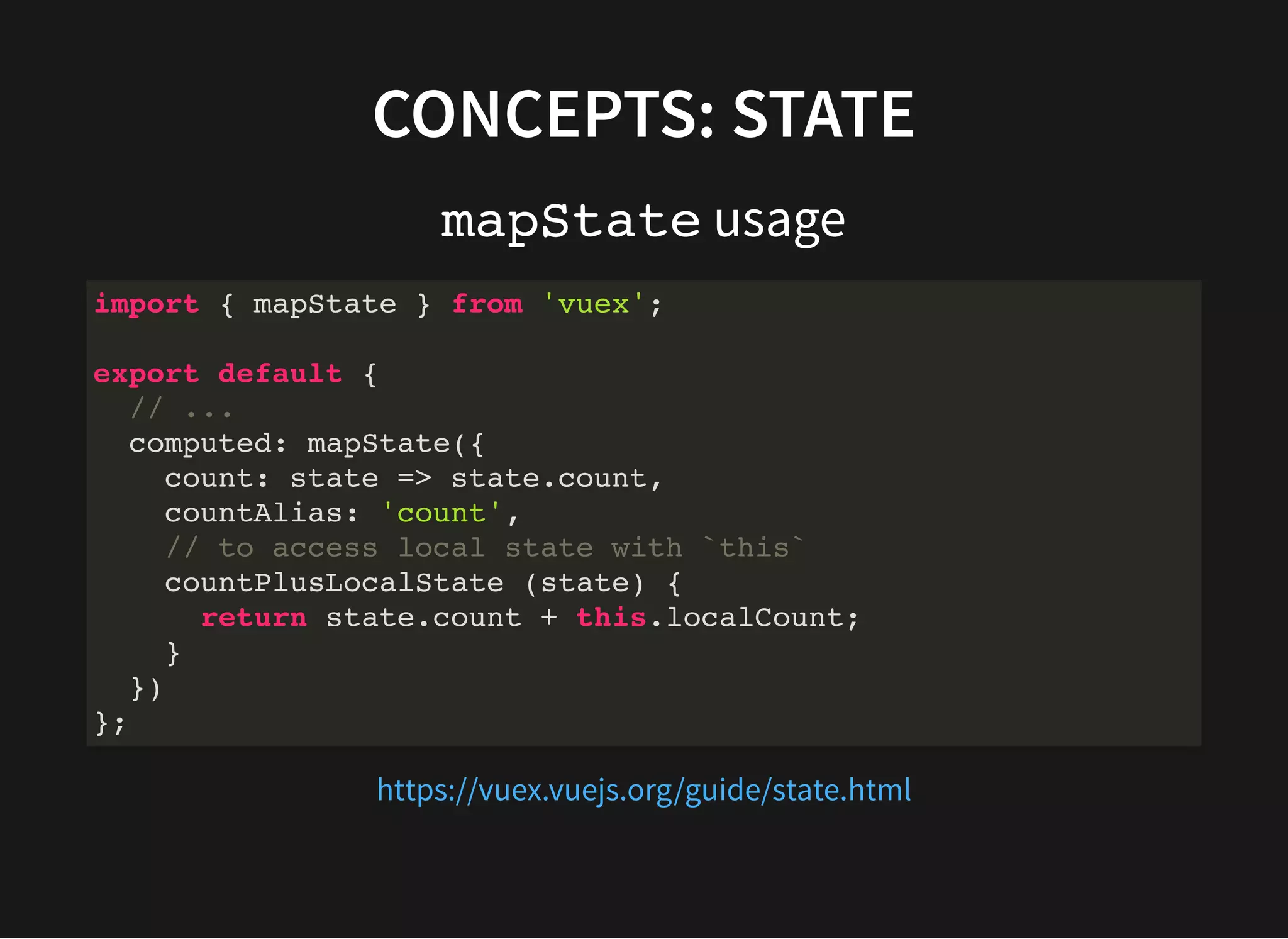
![CONCEPTS: STATE mapState usage simplified is the same as mapState({ count: state => state.count }) mapState([ 'count' ]) https://vuex.vuejs.org/guide/state.html](https://image.slidesharecdn.com/introducing-vuex-210524093112/75/State-manager-in-Vue-js-from-zero-to-Vuex-29-2048.jpg)


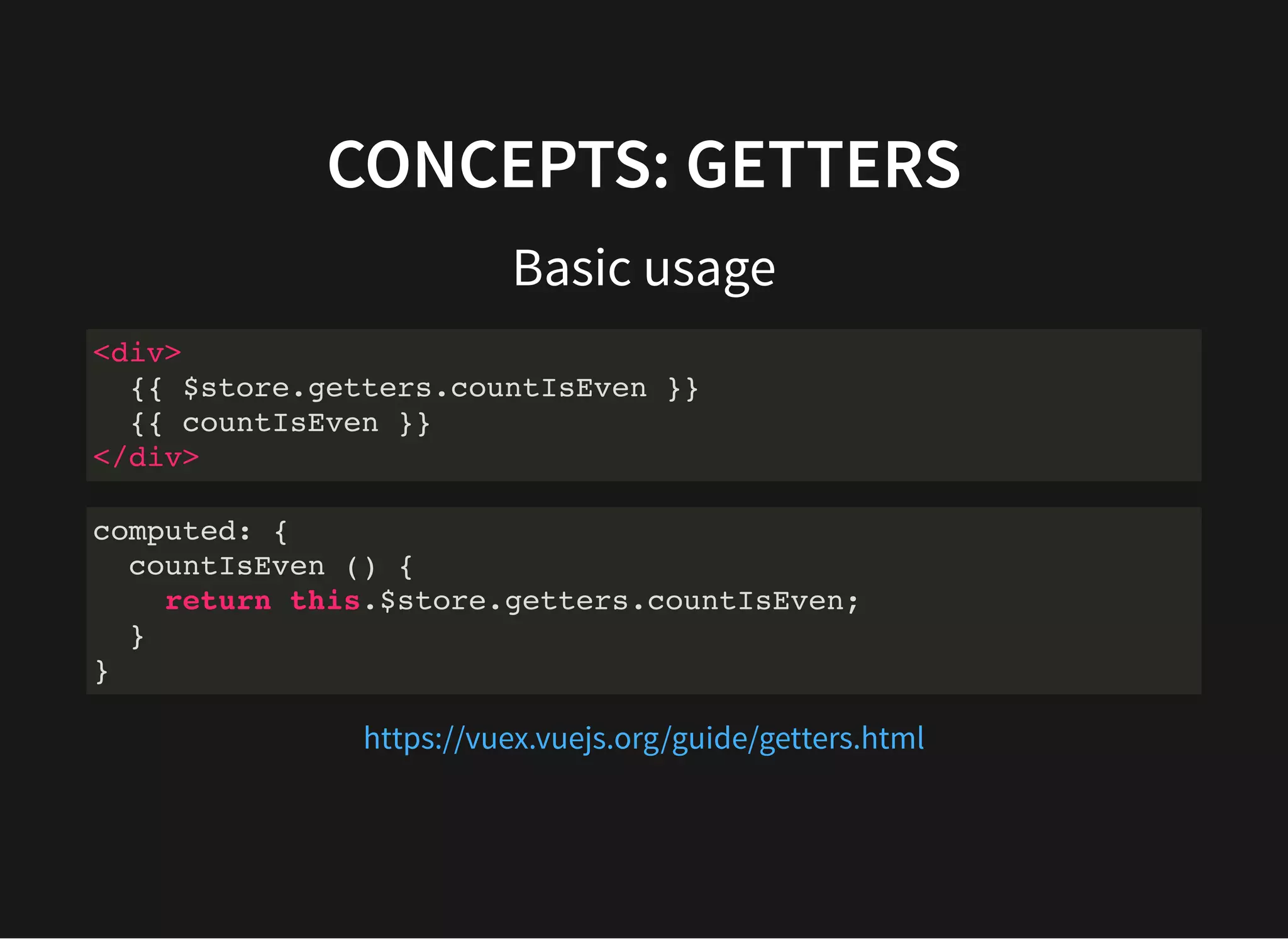

![CONCEPTS: GETTERS mapGetters advanced usage computed: { ...mapState(['count']), ...mapGetters(['countIsEven']), localComputed () { /* ... */ } } https://vuex.vuejs.org/guide/getters.html](https://image.slidesharecdn.com/introducing-vuex-210524093112/75/State-manager-in-Vue-js-from-zero-to-Vuex-34-2048.jpg)
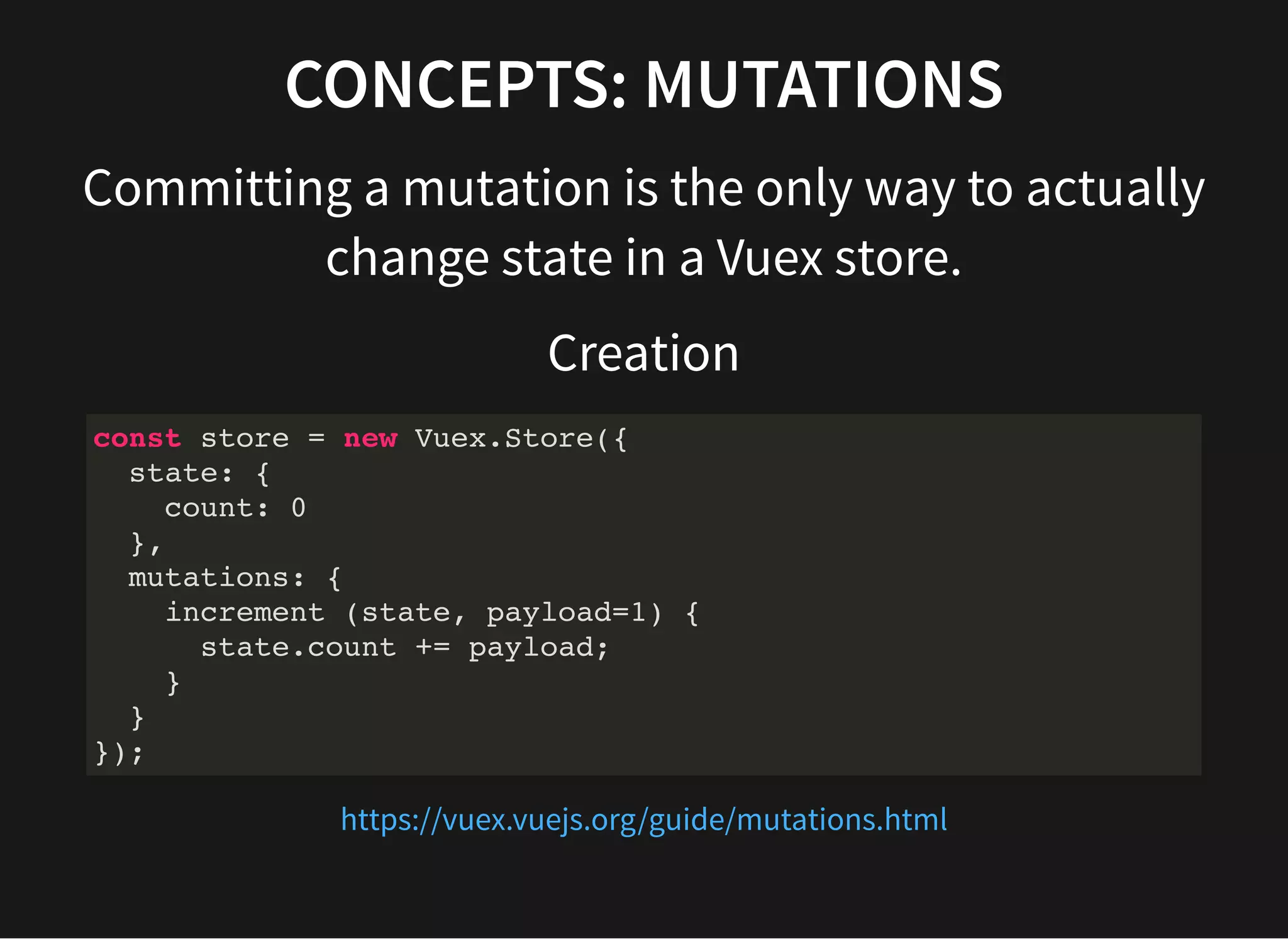
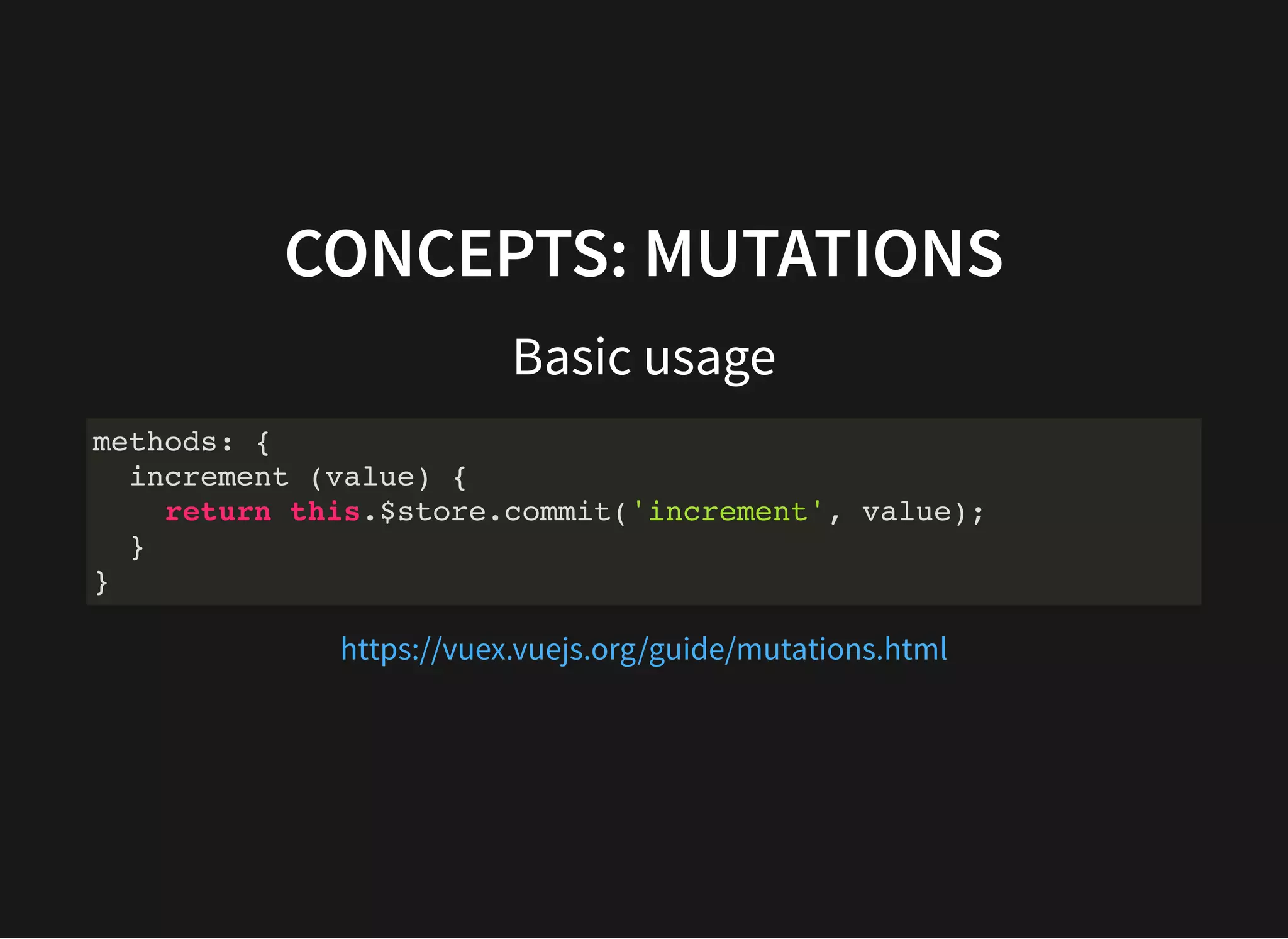
![CONCEPTS: MUTATIONS mapMutations usage import { mapMutations } from 'vuex'; export default { // ... methods: { ...mapMutations([ 'increment' ]), ...mapMutations({ add: 'increment' }) } }; https://vuex.vuejs.org/guide/mutations.html](https://image.slidesharecdn.com/introducing-vuex-210524093112/75/State-manager-in-Vue-js-from-zero-to-Vuex-37-2048.jpg)


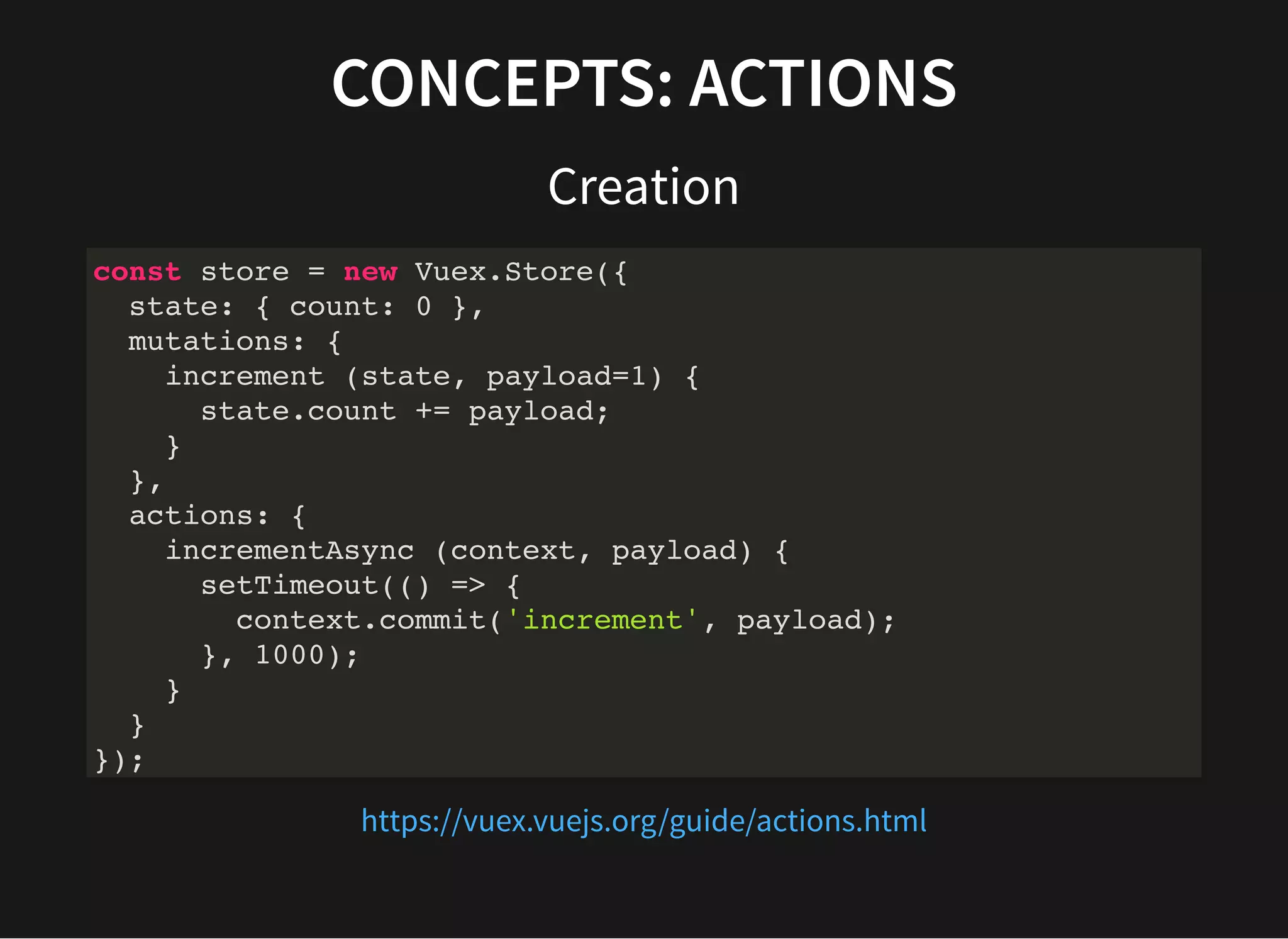
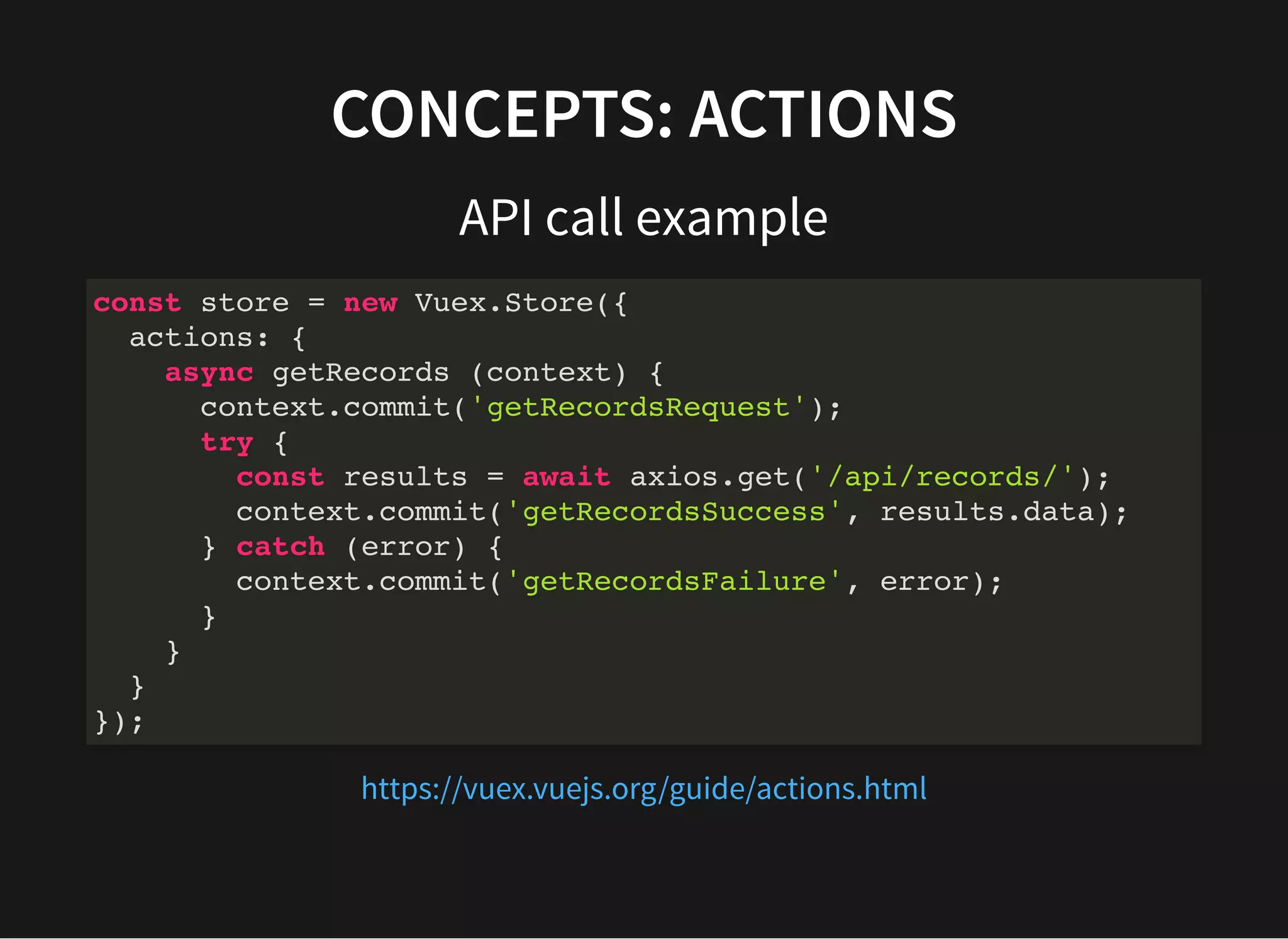
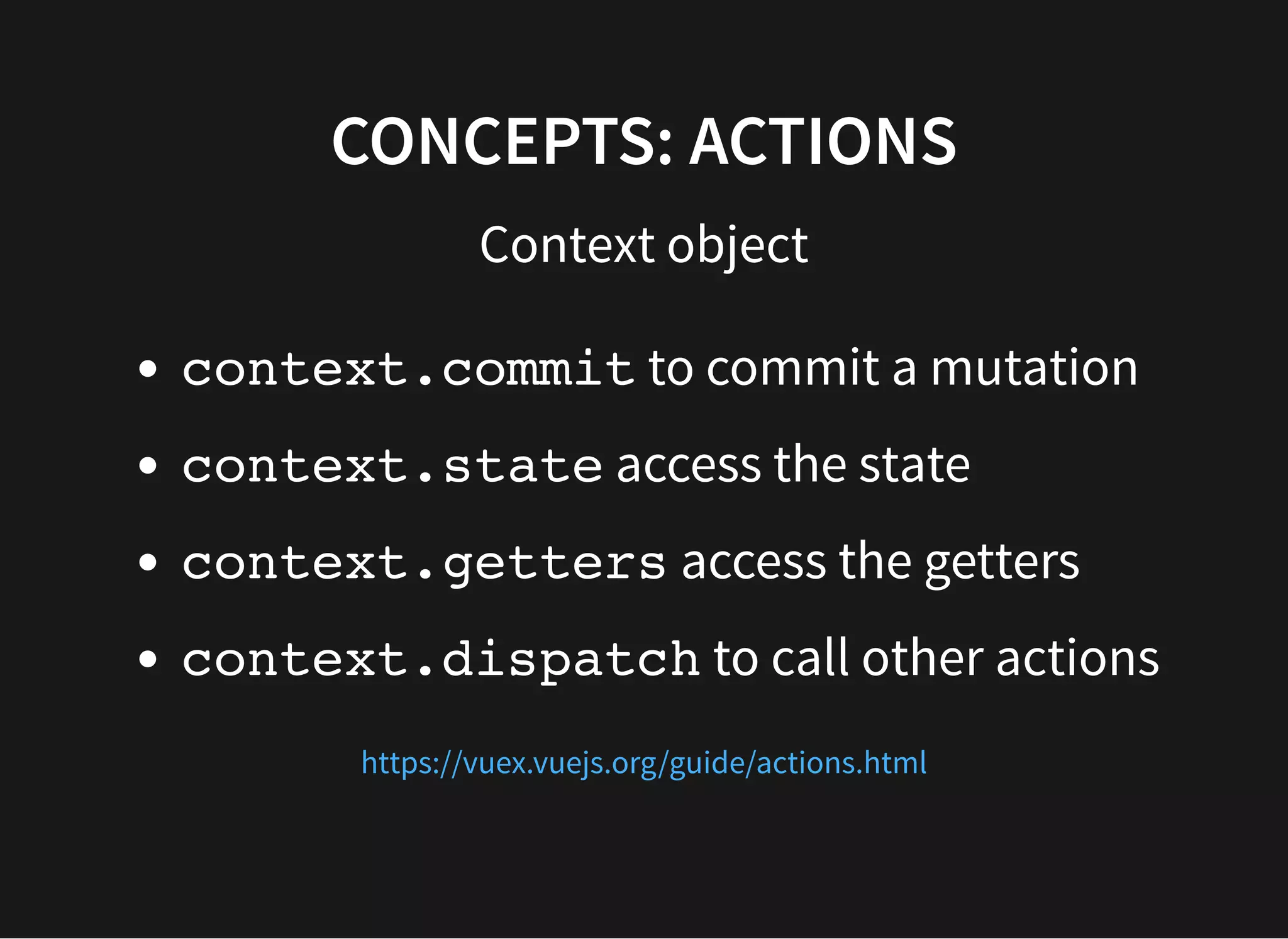
![CONCEPTS: ACTIONS mapActions usage import { mapActions } from 'vuex'; export default { // ... methods: { incrementAsyncLocal (value) { return this.$store.dispatch('incrementAsync', value) .then( /* ... */); } ...mapActions(['incrementAsync']), ...mapActions({ addAsync: 'incrementAsync' }) } }; https://vuex.vuejs.org/guide/actions.html](https://image.slidesharecdn.com/introducing-vuex-210524093112/75/State-manager-in-Vue-js-from-zero-to-Vuex-43-2048.jpg)
![EXAMPLE APP Creating the store, default state // src/store/index.js import Vue from 'vue'; import Vuex from 'vuex'; Vue.use(Vuex); export const defaultState = { availableNumbers: [...Array(90).keys()] .map((i) => i + 1), extractedNumbers: [], };](https://image.slidesharecdn.com/introducing-vuex-210524093112/75/State-manager-in-Vue-js-from-zero-to-Vuex-44-2048.jpg)
![EXAMPLE APP Creating the store, getters // src/store/index.js export const getters = { ascendingExtractedNumbers(state) { return [...state.extractedNumbers].sort((a, b) => a - b); }, };](https://image.slidesharecdn.com/introducing-vuex-210524093112/75/State-manager-in-Vue-js-from-zero-to-Vuex-45-2048.jpg)
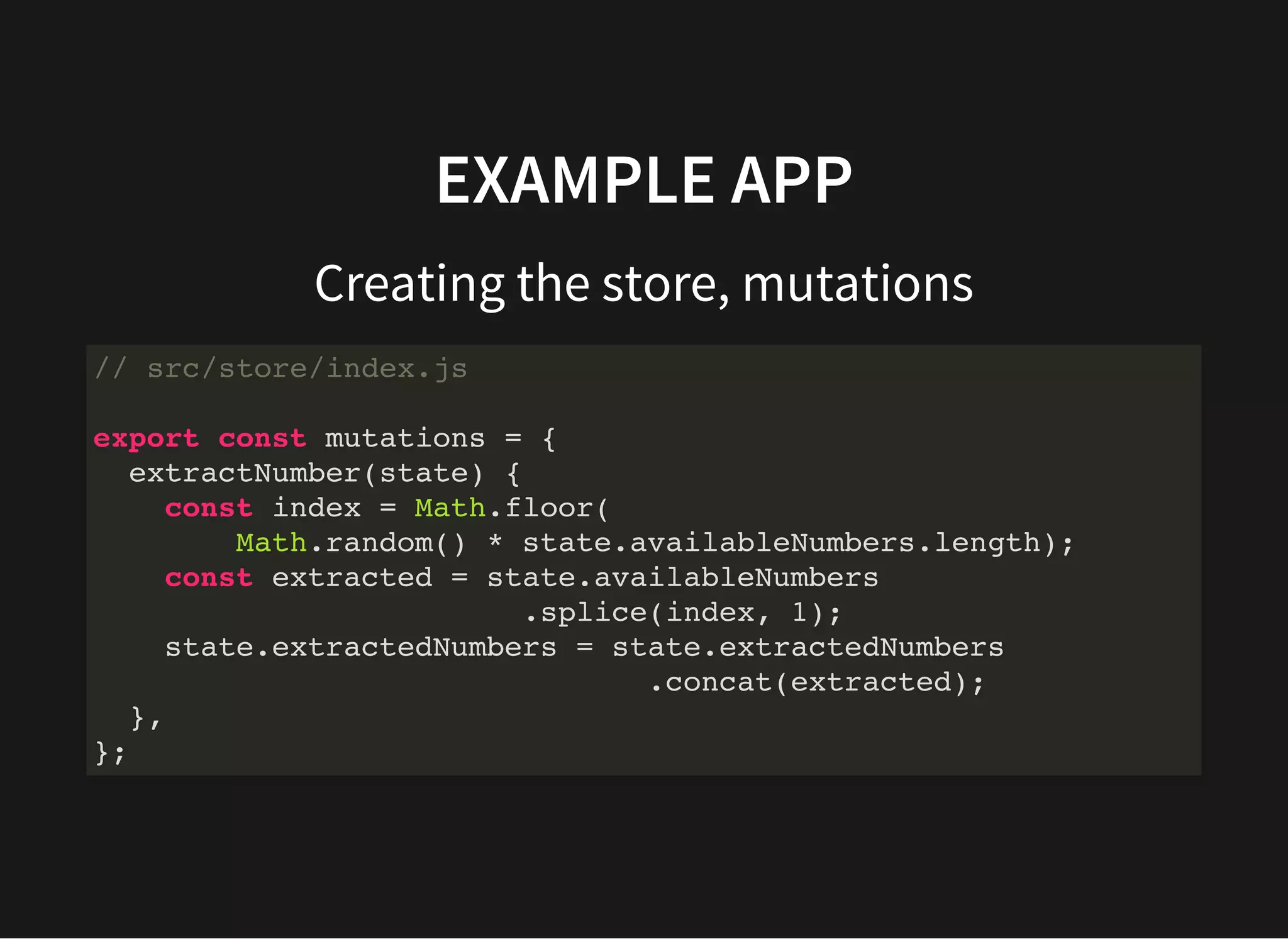
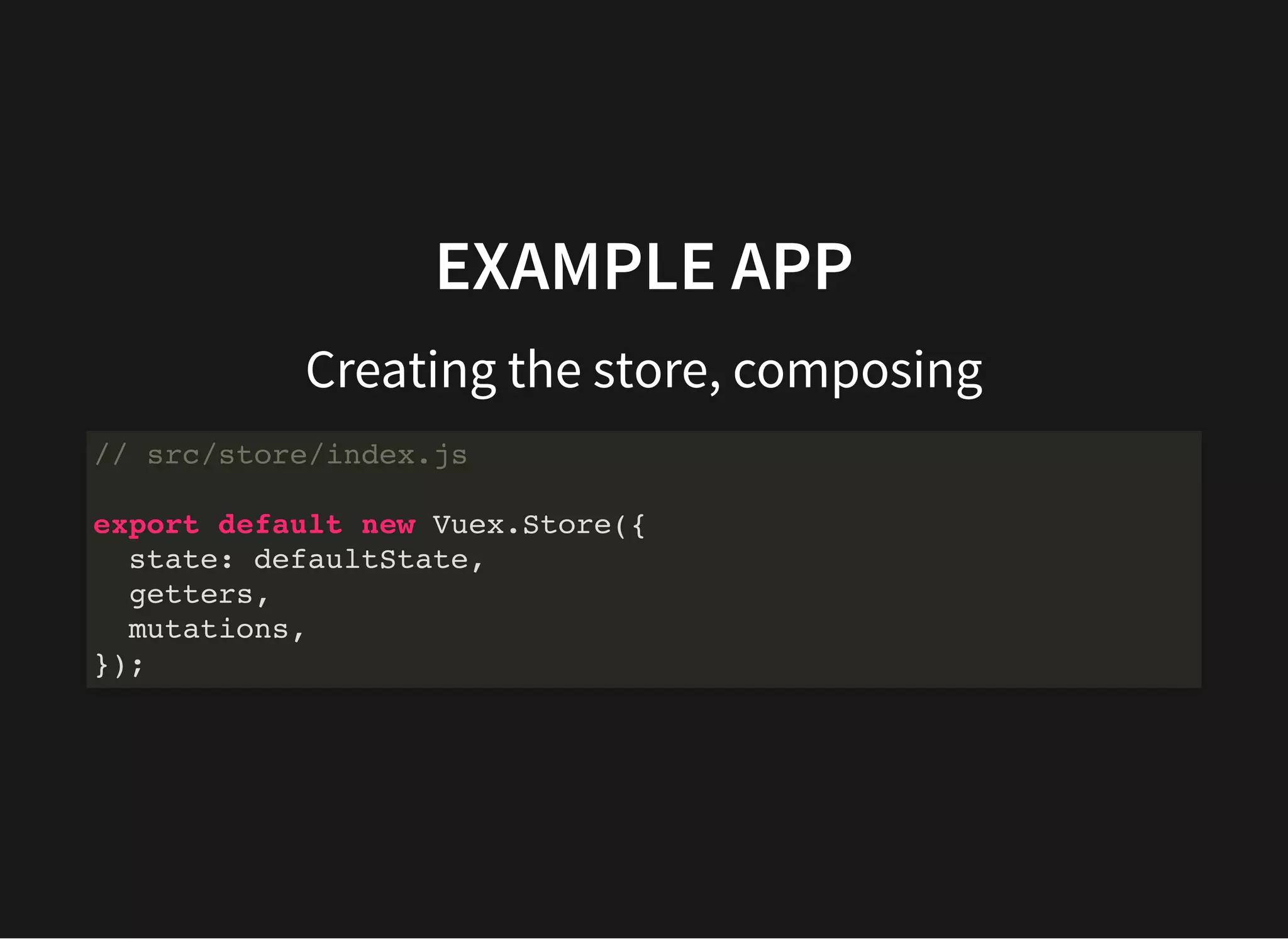
![EXAMPLE APP Home component, data and computed function @@ src/views/Home.vue - data() { - return { - availableNumbers: [...Array(90).keys()].map((i) => i + - extractedNumbers: [], - }; - }, computed: { - ascendingExtractedNumbers() { - return [...this.extractedNumbers].sort((a, b) => a - b) - }, + ...mapState(['availableNumbers', 'extractedNumbers']), + ...mapGetters(['ascendingExtractedNumbers']), },](https://image.slidesharecdn.com/introducing-vuex-210524093112/75/State-manager-in-Vue-js-from-zero-to-Vuex-48-2048.jpg)
![EXAMPLE APP Home component, method @@ src/views/Home.vue - <button @click="handleExtract">Extract</button> + <button @click="extractNumber">Extract</button> methods: { - handleExtract() { - const index = Math.floor(Math.random() * this.available - const extracted = this.availableNumbers.splice(index, 1 - this.extractedNumbers = this.extractedNumbers.concat(ex - }, + ...mapMutations(['extractNumber']), },](https://image.slidesharecdn.com/introducing-vuex-210524093112/75/State-manager-in-Vue-js-from-zero-to-Vuex-49-2048.jpg)
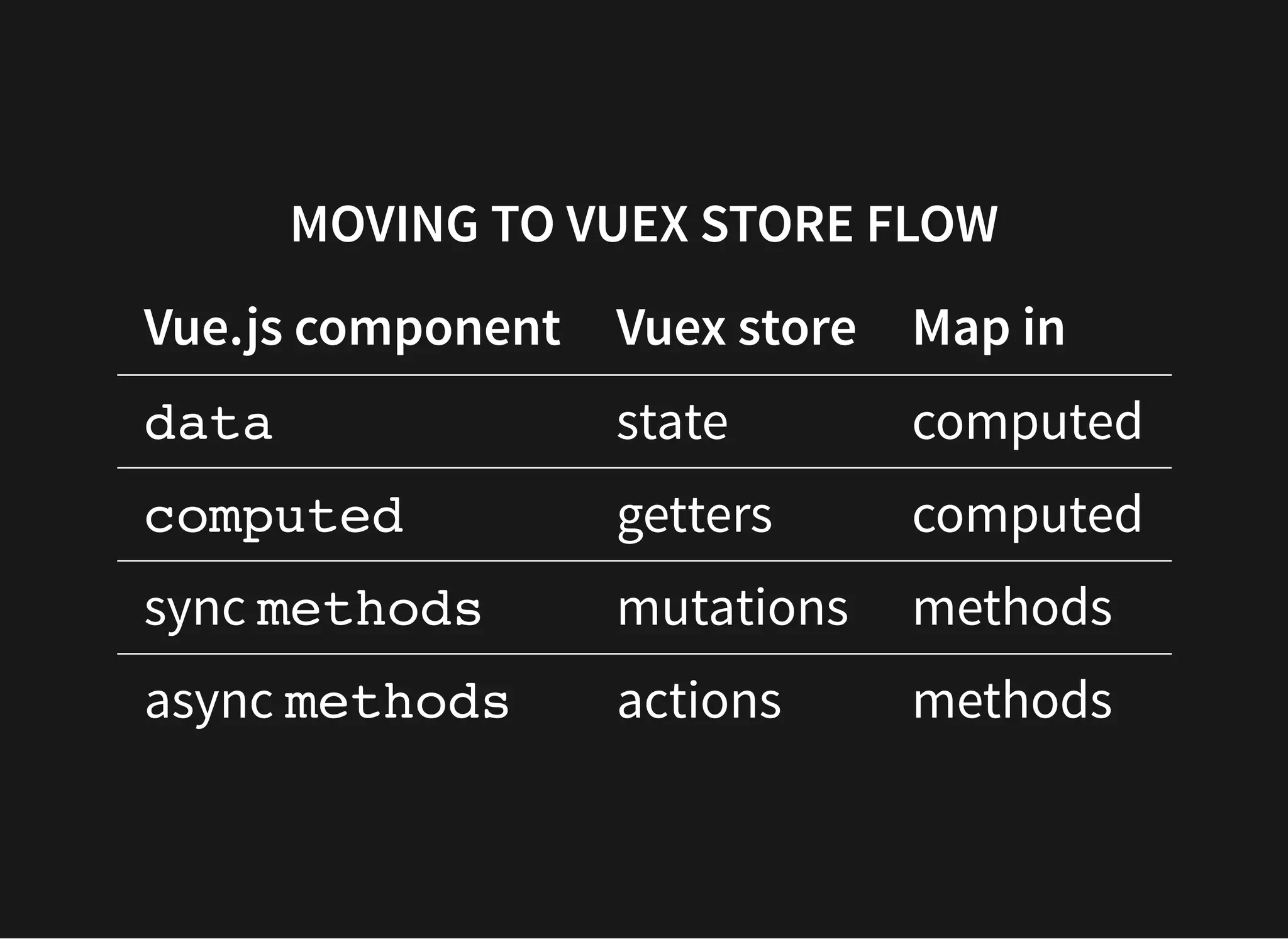
![STORE TESTS Default state import { defaultState } from '@/store'; test('should have the default state', () => { expect(defaultState).toEqual({ availableNumbers: [...Array(90).keys()].map((i) => i + 1), extractedNumbers: [], }); });](https://image.slidesharecdn.com/introducing-vuex-210524093112/75/State-manager-in-Vue-js-from-zero-to-Vuex-51-2048.jpg)
![STORE TESTS Getters import { getters } from '@/store'; const { ascendingExtractedNumbers } = getters; test('ascendingExtractedNumbers', () => { expect( ascendingExtractedNumbers({ extractedNumbers: [12, 56, 34] }) ).toEqual([12, 34, 56]); });](https://image.slidesharecdn.com/introducing-vuex-210524093112/75/State-manager-in-Vue-js-from-zero-to-Vuex-52-2048.jpg)
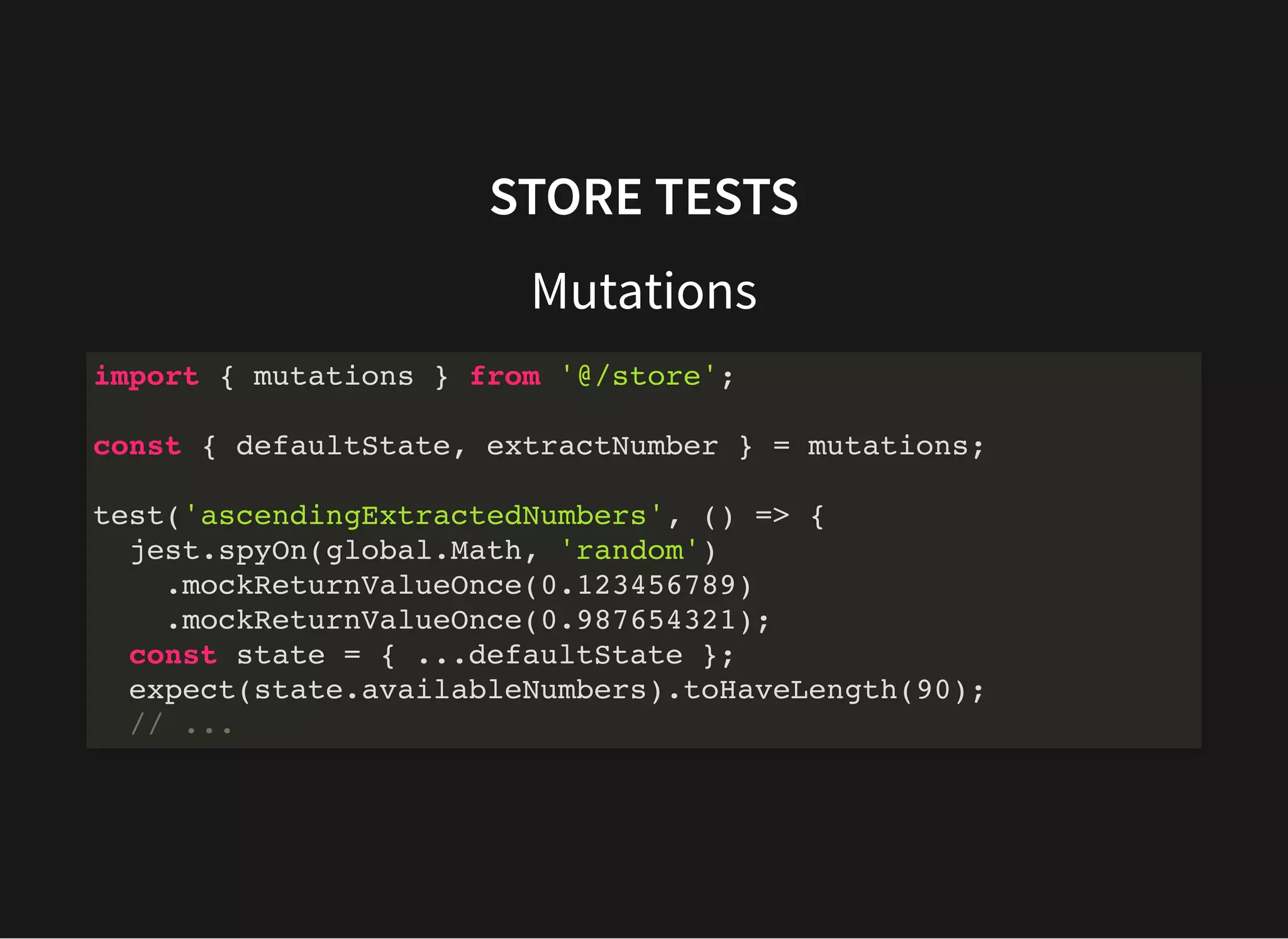
![STORE TESTS Mutations // ... extractNumber(state); expect(state.availableNumbers).toHaveLength(89); expect(state.extractedNumbers).toEqual([12]); extractNumber(state); expect(state.availableNumbers).toHaveLength(88); expect(state.extractedNumbers).toEqual([12, 89]); jest.spyOn(global.Math, 'random').mockRestore(); });](https://image.slidesharecdn.com/introducing-vuex-210524093112/75/State-manager-in-Vue-js-from-zero-to-Vuex-54-2048.jpg)
